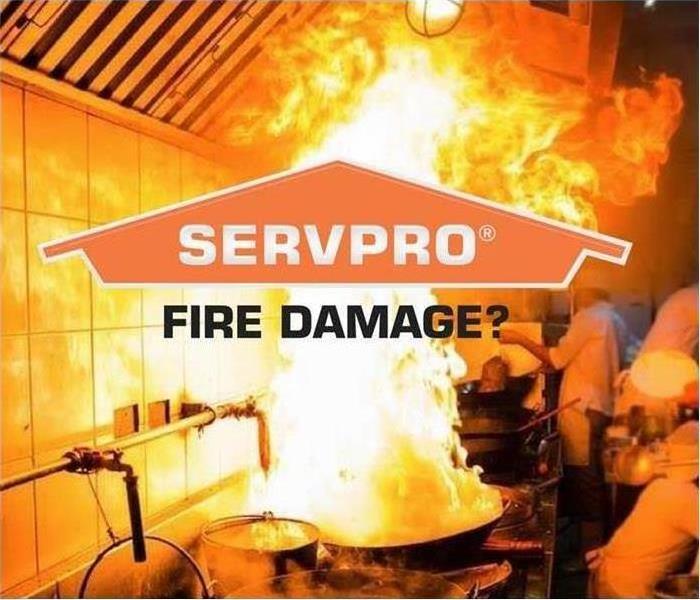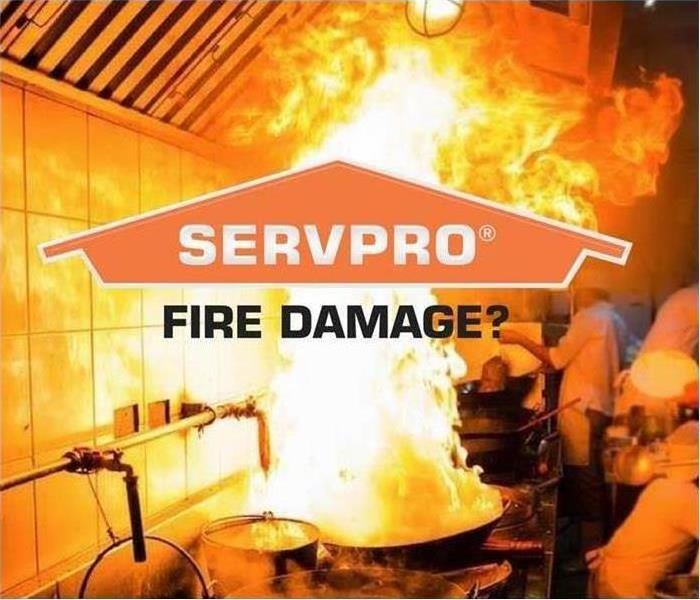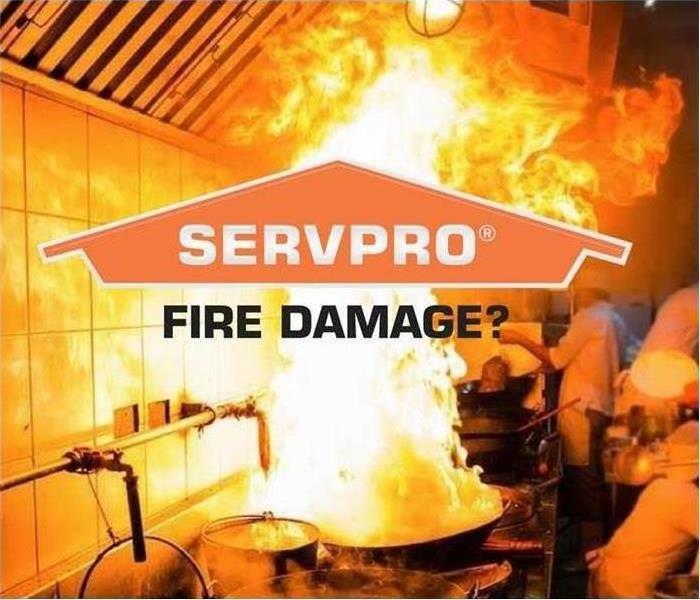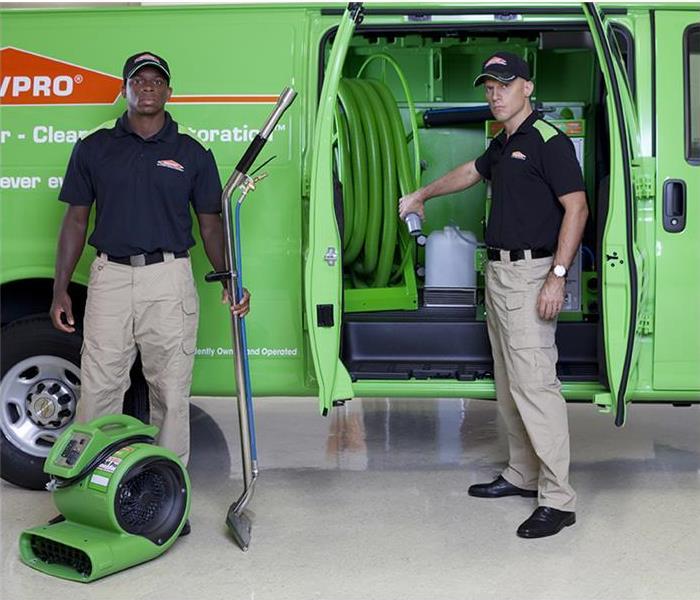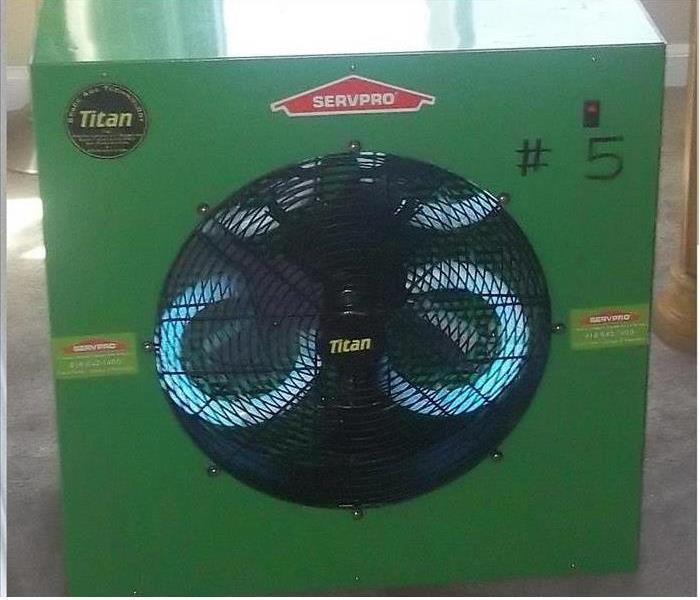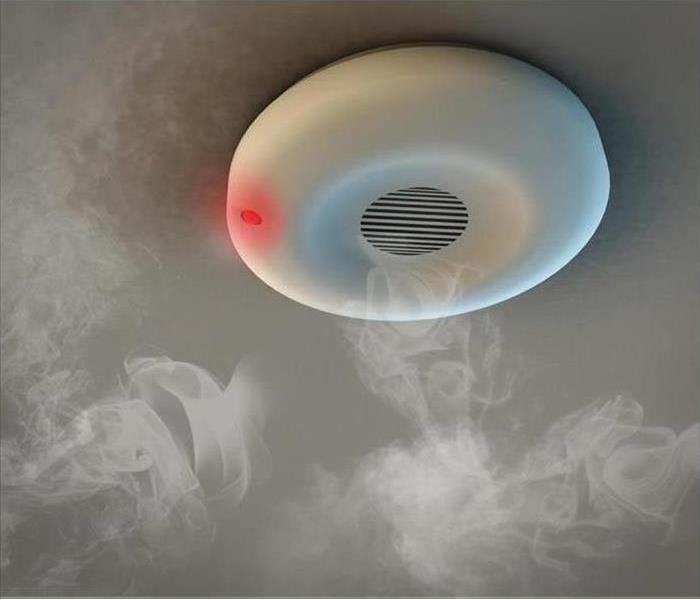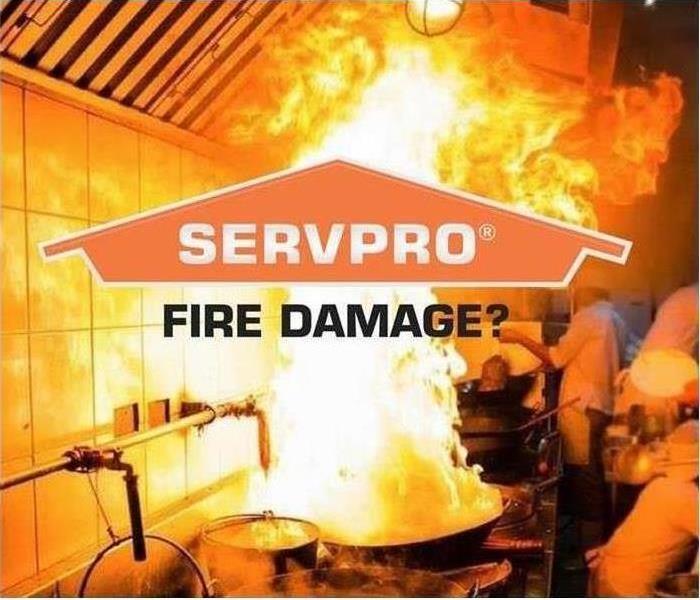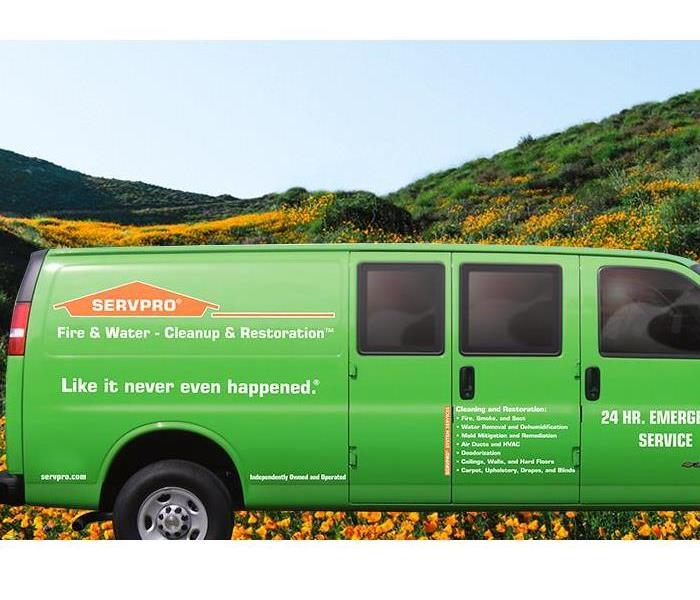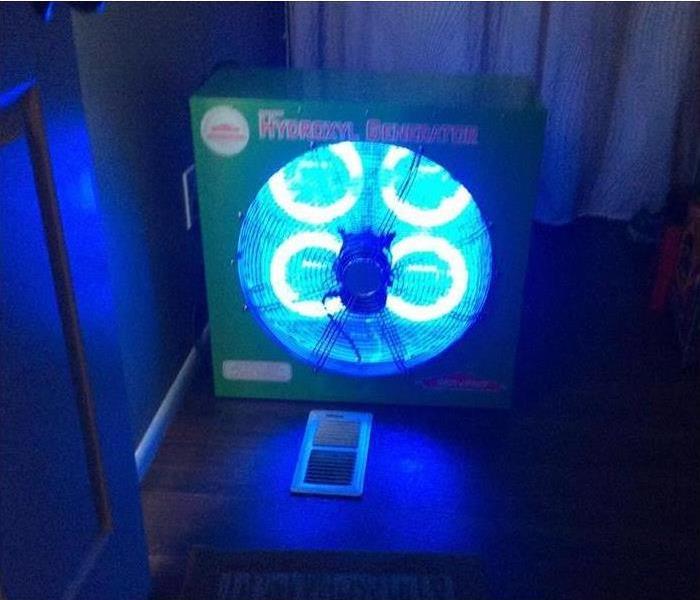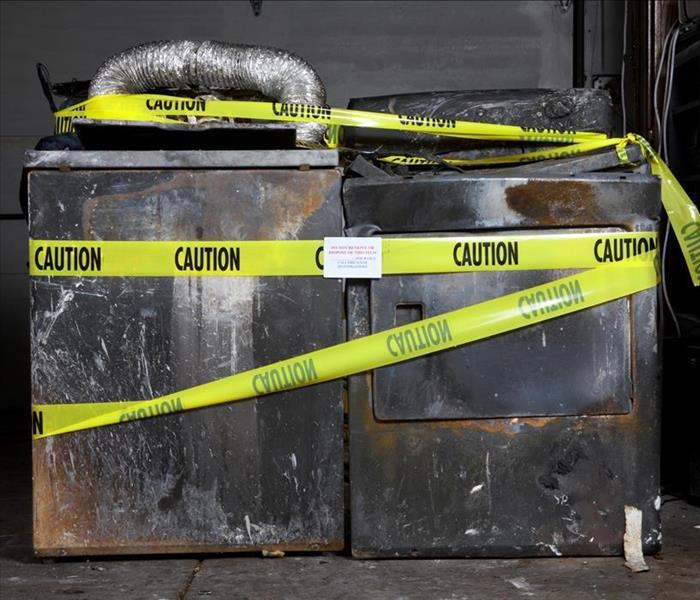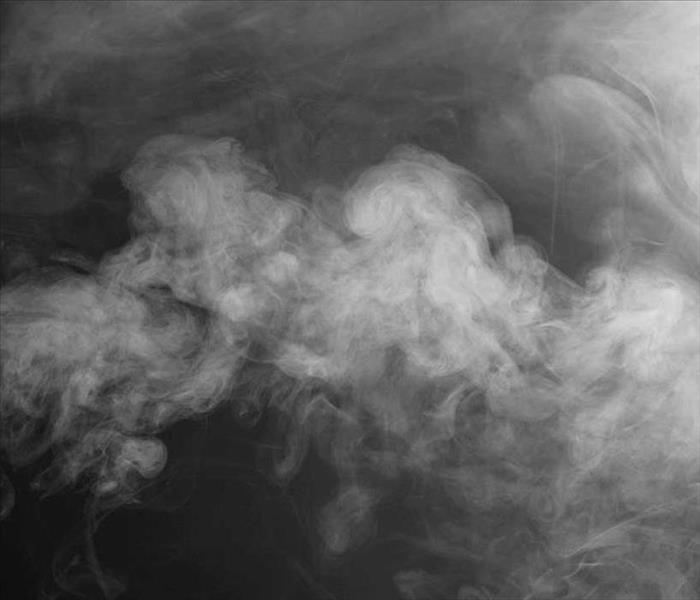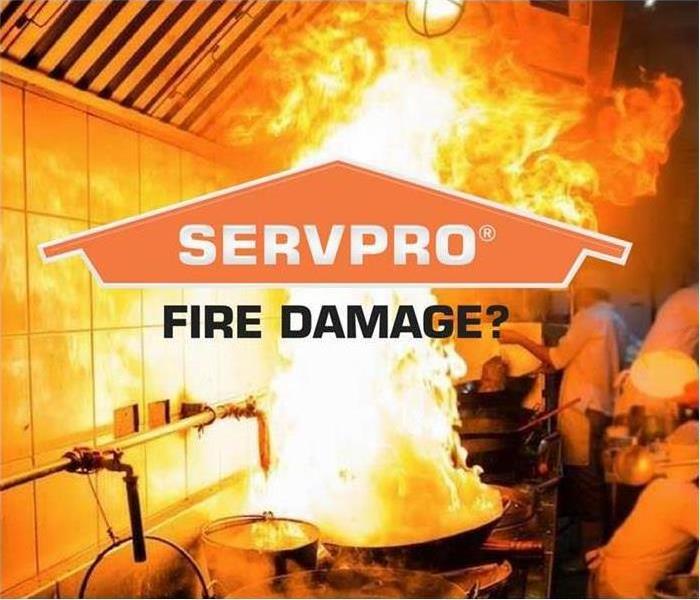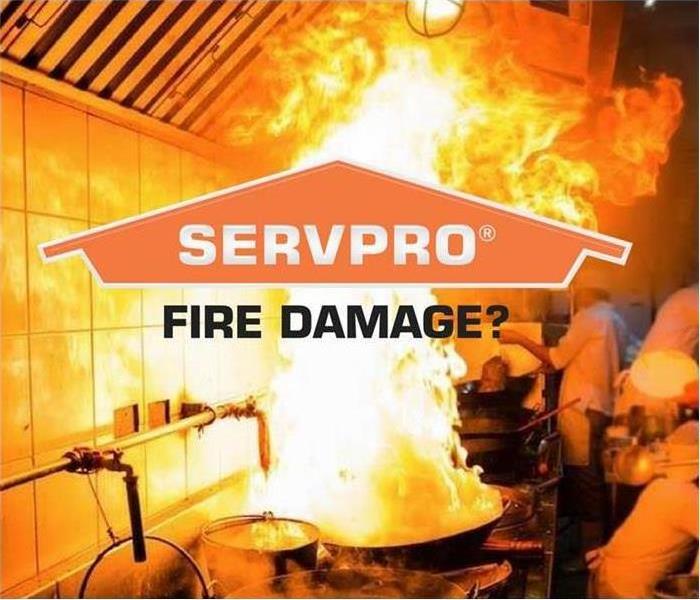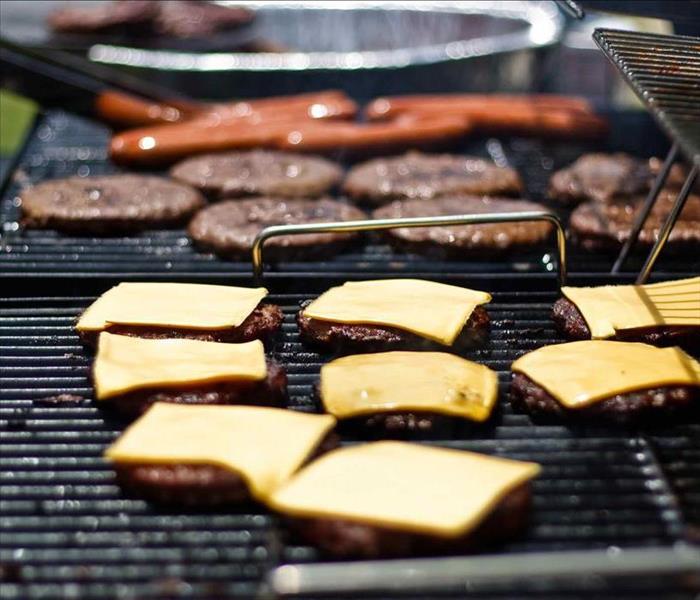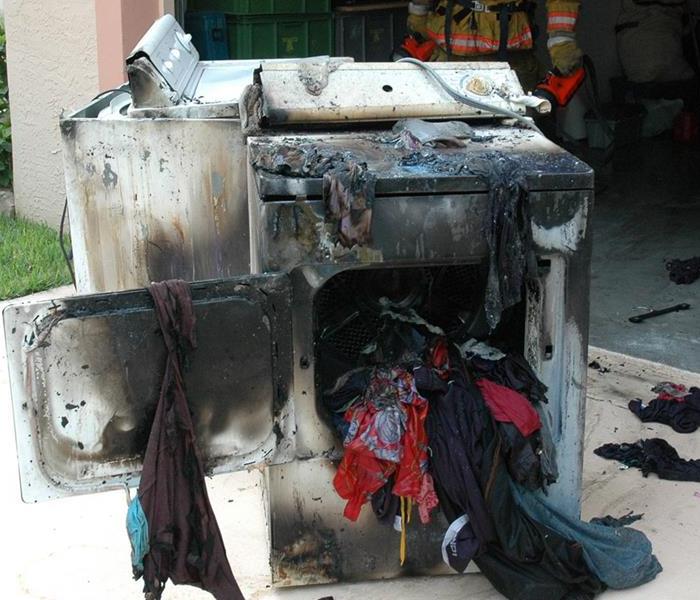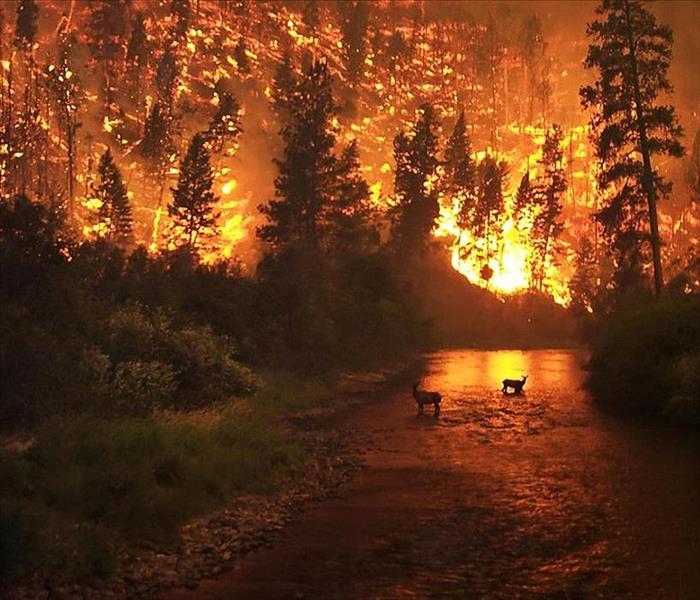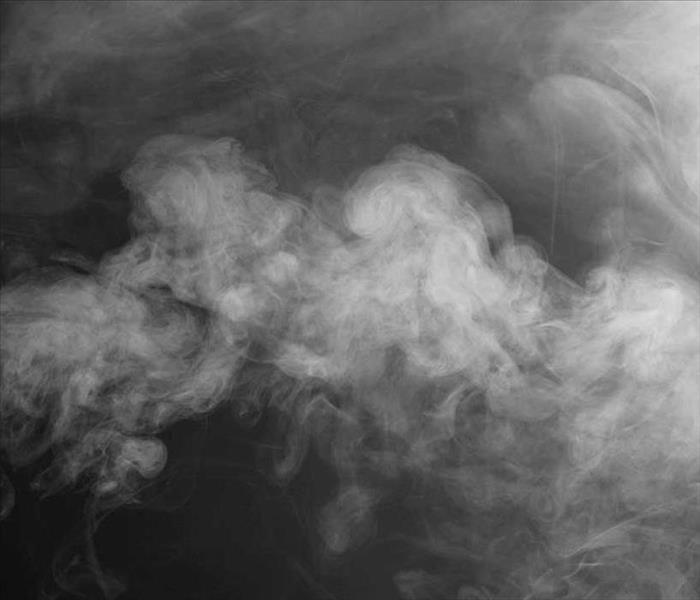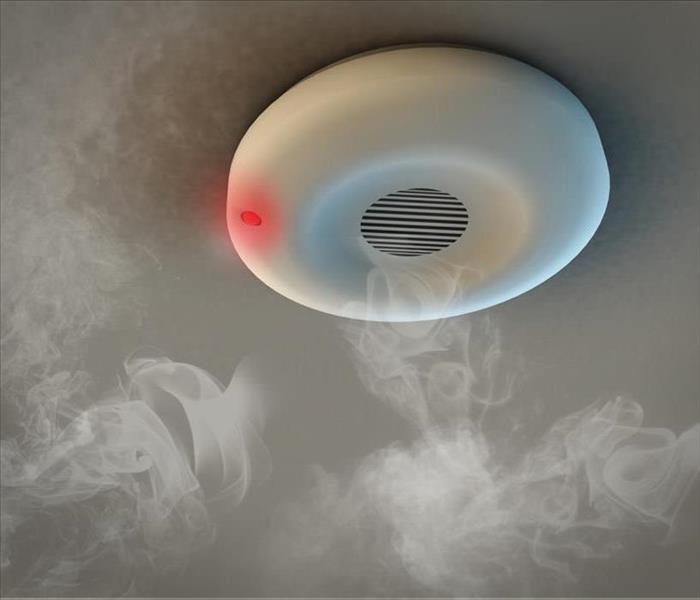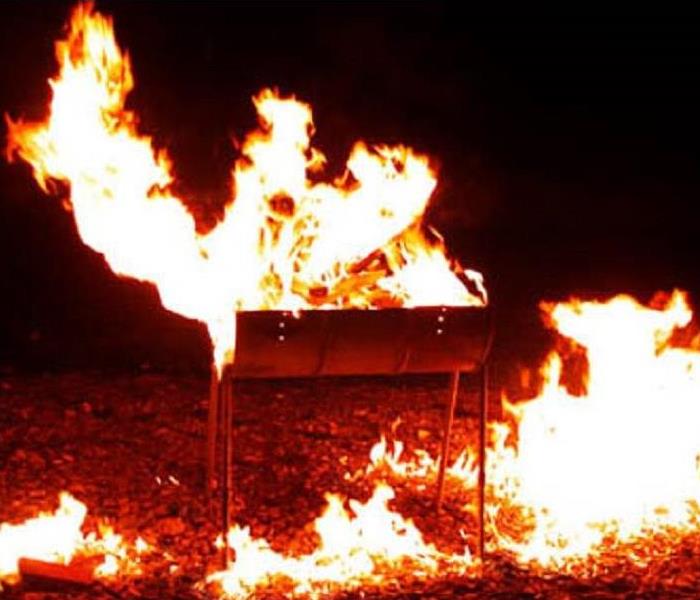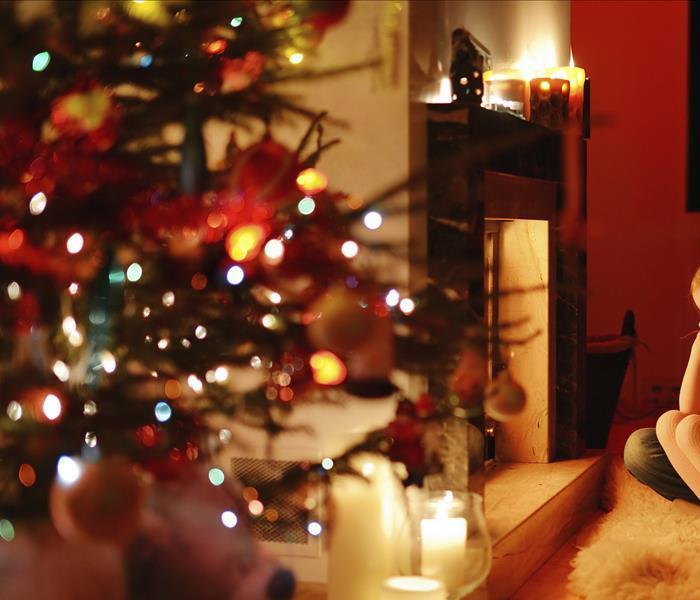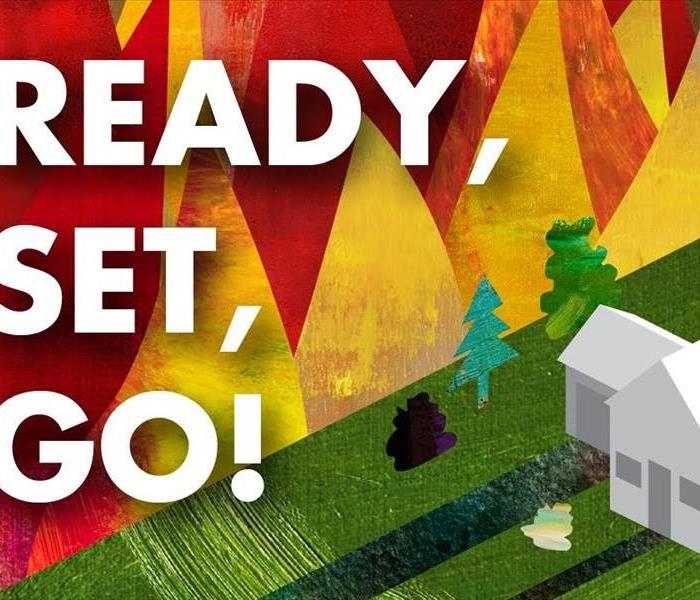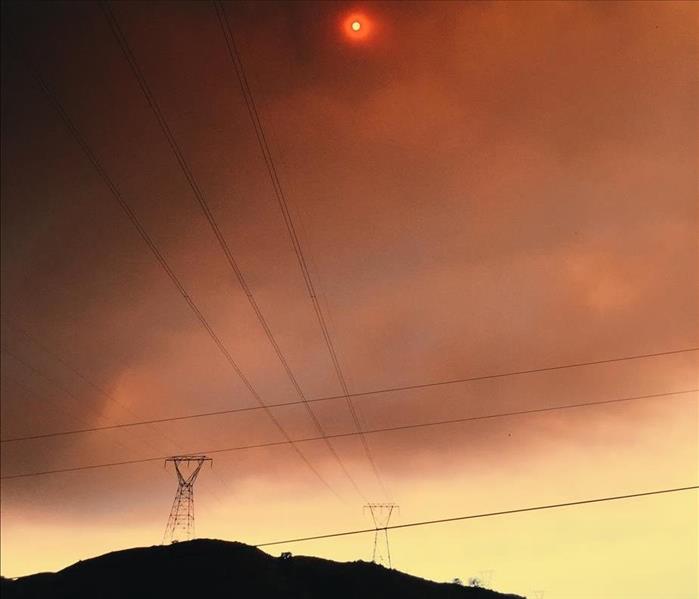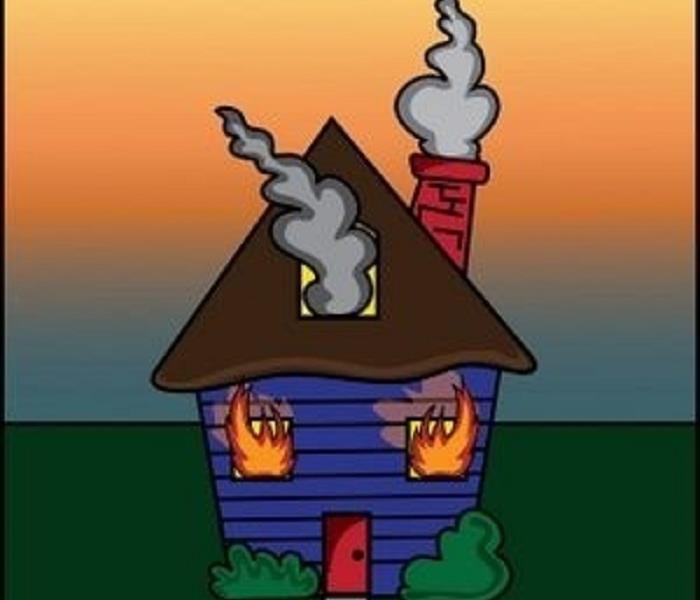Archived Fire Damage Blog Posts
Burbank Wildfire Damage Event
10/10/2024 (Permalink)
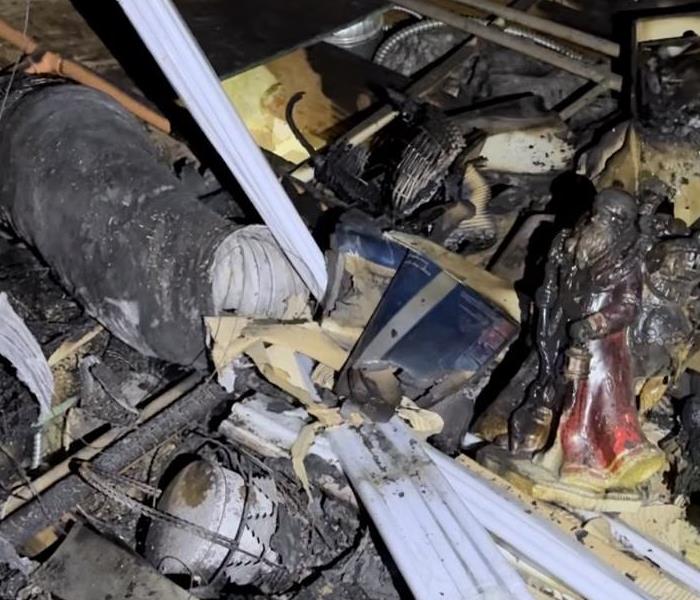 SERVPRO of Burbank provides fire, soot and water damage restoration service in Burbank
SERVPRO of Burbank provides fire, soot and water damage restoration service in Burbank
The active wildfires here in Southern California are increasing their impact as growing Santa Ana winds add fuel to these devastating blazes that are encroaching in our area. According to the New York Times, new fires broke out in Malibu on December 7, with at least 96,000 acres already burned in the Ventura area and 116,000 acres in Los Angeles County. Evacuations have closed hundreds of schools and forced 200,000 of our neighbors to seek safety. The “Thomas Fire” in the Ventura area continues to burn with the aid of strong winds. This fire has caused the closure of the 101 freeway and a boil-water advisory was issued for Ventura County. The Santa Ana winds that are enabling the fires to rapidly increase their reach can have speeds in excess of 60 miles per hour. They are not expected to diminish until Friday into Saturday, at the earliest. The National Weather Service has warned of “very rapid fire growth” in this area. SERVPRO Meteorologist Lela Davis said that the Santa Ana winds were already very dry when they reached the Southern California valley, allowing them to quickly pull moisture out of vegetation, increasing the risk for wildfires. For the first time ever, a purple wind warning was issued for today under the color-coded system used to advise about high winds. This purple warning pushed wind expectations from the “high” category to “extreme”.
Ready 24/7 to Help
Here at SERVPRO of [Franchise name], we are monitoring this wildfire situation closely. Our thoughts are with those neighbors who may be put in harms’ way during this event. In many cases, a wildfire can result in a total loss for a home or business, but in others it may be a partial loss, or can result in mild smoke damage. If your home or business is affected by a wildfire, SERVPRO of Burbank is Here to Help®.
About SERVPRO of Burbank
SERVPRO of Burbank specializes in the cleanup and restoration of residential and commercial property after a fire, smoke or water damage event. Our staff is highly trained in property damage restoration. From initial and ongoing training at SERVPRO’s corporate training facility to regular IICRC-industry certification, rest assured our staff is equipped with the knowledge to restore your property.
Crescenta Valley/East Glendale Wildfire Damage Event
10/9/2024 (Permalink)
 SERVPRO of Crescenta Valley/East Glendale provides fire, soot and water damage restoration service in Crescenta Valley East Glendale
SERVPRO of Crescenta Valley/East Glendale provides fire, soot and water damage restoration service in Crescenta Valley East Glendale
The active wildfires here in Southern California are increasing their impact as growing Santa Ana winds add fuel to these devastating blazes that are encroaching in our area. According to the New York Times, new fires broke out in Malibu on December 7, with at least 96,000 acres already burned in the Ventura area and 116,000 acres in Los Angeles County. Evacuations have closed hundreds of schools and forced 200,000 of our neighbors to seek safety. The “Thomas Fire” in the Ventura area continues to burn with the aid of strong winds. This fire has caused the closure of the 101 freeway and a boil-water advisory was issued for Ventura County. The Santa Ana winds that are enabling the fires to rapidly increase their reach can have speeds in excess of 60 miles per hour. They are not expected to diminish until Friday into Saturday, at the earliest. The National Weather Service has warned of “very rapid fire growth” in this area. SERVPRO Meteorologist Lela Davis said that the Santa Ana winds were already very dry when they reached the Southern California valley, allowing them to quickly pull moisture out of vegetation, increasing the risk for wildfires. For the first time ever, a purple wind warning was issued for today under the color-coded system used to advise about high winds. This purple warning pushed wind expectations from the “high” category to “extreme”.
Ready 24/7 to Help
Here at SERVPRO of Crescenta Valley/East Glendale, we are monitoring this wildfire situation closely. Our thoughts are with those neighbors who may be put in harms’ way during this event. In many cases, a wildfire can result in a total loss for a home or business, but in others it may be a partial loss, or can result in mild smoke damage. If your home or business is affected by a wildfire, SERVPRO of Crescenta Valley/East Glendale is Here to Help®.
About SERVPRO of
The active wildfires here in Southern California are increasing their impact as growing Santa Ana winds add fuel to these devastating blazes that are encroaching in our area. According to the New York Times, new fires broke out in Malibu on December 7, with at least 96,000 acres already burned in the Ventura area and 116,000 acres in Los Angeles County. Evacuations have closed hundreds of schools and forced 200,000 of our neighbors to seek safety. The “Thomas Fire” in the Ventura area continues to burn with the aid of strong winds. This fire has caused the closure of the 101 freeway and a boil-water advisory was issued for Ventura County. The Santa Ana winds that are enabling the fires to rapidly increase their reach can have speeds in excess of 60 miles per hour. They are not expected to diminish until Friday into Saturday, at the earliest. The National Weather Service has warned of “very rapid fire growth” in this area. SERVPRO Meteorologist Lela Davis said that the Santa Ana winds were already very dry when they reached the Southern California valley, allowing them to quickly pull moisture out of vegetation, increasing the risk for wildfires. For the first time ever, a purple wind warning was issued for today under the color-coded system used to advise about high winds. This purple warning pushed wind expectations from the “high” category to “extreme”.
Ready 24/7 to Help
Here at SERVPRO of [Franchise name], we are monitoring this wildfire situation closely. Our thoughts are with those neighbors who may be put in harms’ way during this event. In many cases, a wildfire can result in a total loss for a home or business, but in others it may be a partial loss, or can result in mild smoke damage. If your home or business is affected by a wildfire, SERVPRO of Crescenta Valley/East Glendale is Here to Help®.
About SERVPRO of Crescenta Valley East Glendale
SERVPRO of Crescenta Valley/East Glendale specializes in the cleanup and restoration of residential and commercial property after a fire, smoke or water damage event. Our staff is highly trained in property damage restoration. From initial and ongoing training at SERVPRO’s corporate training facility to regular IICRC-industry certification, rest assured our staff is equipped with the knowledge to restore your property.
SERVPRO of Crescenta Valley/East Glendale specializes in the cleanup and restoration of residential and commercial property after a fire, smoke or water damage event. Our staff is highly trained in property damage restoration. From initial and ongoing training at SERVPRO’s corporate training facility to regular IICRC-industry certification, rest assured our staff is equipped with the knowledge to restore your property.
Crescenta Valley/East Glendale Smoke and Soot Cleanup
10/9/2024 (Permalink)
Smoke and soot is very invasive and can penetrate various cavities within your home, causing hidden damage and odor. Our smoke damage expertise and experience allows us to inspect and accurately assess the extent of the damage to develop a comprehensive plan of action.
Smoke and soot facts:
- Hot smoke migrates to cooler areas and upper levels of a structure.
- Smoke flows around plumbing systems, seeping through the holes used by pipes to go from floor to floor.
- The type of smoke may greatly affect the restoration process.
Different Types of Smoke
There are two different types of smoke–wet and dry. As a result, there are different types of soot residue after a fire. Before restoration begins, SERVPRO of Crescenta Valley/East Glendale will test the soot to determine which type of smoke damage occurred. The cleaning procedures will then be based on the information identified during pretesting. Here is some additional information:
Wet Smoke – Plastic and Rubber
- Low heat, smoldering, pungent odor, sticky, smeary. Smoke webs are more difficult to clean.
Dry Smoke – Paper and Wood
- Fast burning, high temperatures, heat rises, therefore smoke rises.
Protein Fire Residue – Produced by evaporation of material rather than from a fire
- Virtually invisible, discolors paints and varnishes, extreme pungent odor.
Our Fire Damage Restoration Services
Since each smoke and fire damage situation is a little different, each one requires a unique solution tailored for the specific conditions. We have the equipment, expertise, and experience to restore your fire and smoke damage. We will also treat your family with empathy and respect and your property with care.
Have Questions about Fire, Smoke, or Soot Damage?
Soot and Smoke
10/2/2023 (Permalink)
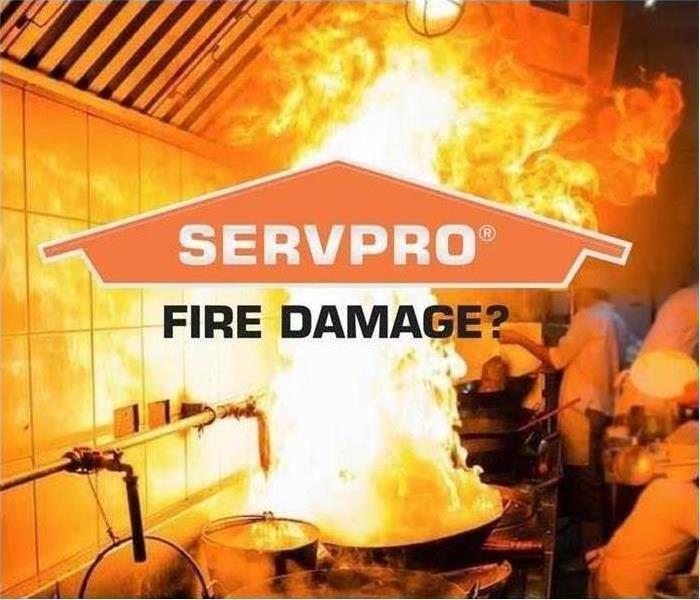 Fire Damage
Fire Damage
After experiencing a fire it is clear there are many different types of fire damage that need to be examined. A very important and destructive form of fire damage is the smoke and soot. One reason smoke and soot can be so damaging is the fact the extent of the damage is usually hidden fairly well. Our smoke damage expertise and experience allows us to inspect and accurately assess the extent of the damage to develop a comprehensive plan of action.
Different Types of Smoke:
When it comes to smoke there are two different types of smoke–wet and dry. As a result, there are different types of soot residue after a fire. SERVPRO® of Burbank starts by testing the soot to determine which type of smoke damage occurred. The cleaning procedures will then be based on the information identified during pretesting. Here is some additional information:
Wet Smoke – Plastic and Rubber
- Low heat, smoldering, pungent odor, sticky, smeary. Smoke webs are more difficult to clean.
Dry Smoke – Paper and Wood
- Fast burning, high temperatures, heat rises therefore smoke rises.
Protein Fire Residue – Produced by evaporation of material rather than from a fire
- Virtually invisible, discolors paints and varnishes, extreme pungent odor.
Smoke and soot facts:
To bring some more understanding on how smoke and soot work, here are some facts that could be potentially useful.
- Hot smoke migrates to cooler areas and upper levels of a structure.
- Smoke flows around plumbing systems, seeping through the holes used by pipes to go from floor to floor.
- The type of smoke may greatly affect the restoration process.
Our Fire Damage Restoration Services:
Since each smoke and fire damage situation is a little different, each one requires a unique solution tailored for the specific conditions. We have the equipment, expertise, and experience to restore your fire and smoke damage.
Have Questions about Fire, Smoke, or Soot Damage?
Call Us Today – (818) 842-1400
Fire Prevention
10/2/2023 (Permalink)
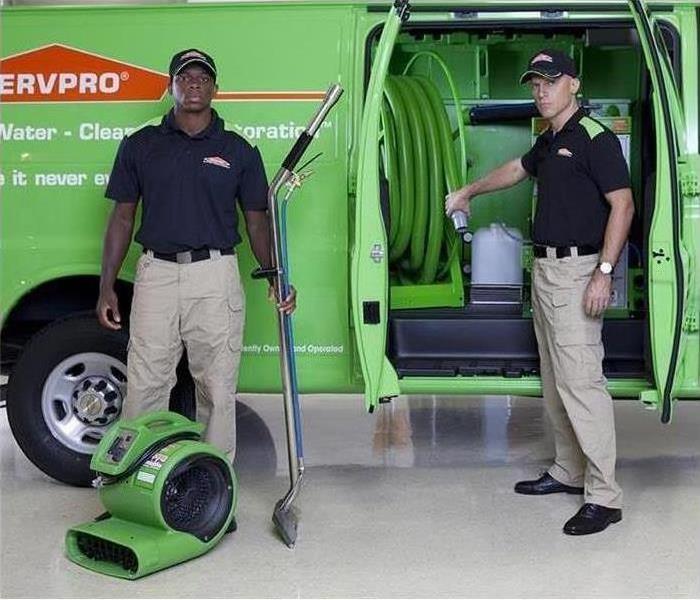 SERVPRO Crew with drying equipment
SERVPRO Crew with drying equipment
Most people know the basics of fire safety at home, such as not leaving burning candles unattended and keeping a fire extinguisher on hand. Here are a few more things you can do to prevent fires at home.
- Have your heating system serviced regularly by a professional.
- Including chimneys from wood-burning fireplaces. Clean around heat sources and keep dust and other flammable items away from ignition sources.
- Remove the lint from your dryer filter after every use.
- A clogged filter and lint trap makes your dryer less efficient, reduces the airflow needed to keep heat from building up in the vents, and forces lint onto the heating coils. Also, never let your dryer run when you are out of the house or when you’re asleep.
- Keep firewood, piles of leaves and trash away from the home.
- If a grass fire starts nearby, these items next to your home could easily become kindling. Never dump hot ashes inside or near your home; keep them in a metal container well away from your house and garage.
- Avoid using outlet extenders or plug-in power bars:
- They can quickly overload an electrical circuit. Replace old, damaged or frayed appliance cords, and never force a three-pronged plug into a two-slot outlet or extension cord.
- Store containers of cooking oil well away from the stove.
- When cooking with oil, never leave the stove unattended. To stop a grease fire, turn off the burner and place a lid on the pan to suffocate the flames, or pour on lots of baking soda. Never pour water on a grease fire or try to carry the pan outside; water splatters the grease and makes the fire bigger, and the pan will be much too hot to carry.
- Consider using borrowed heat to keep outdoor pets warm.
- During winter months, avoid using heat lamps, solar lamps, trouble lights, heated watering bowls or other such heated devices, which could lead to a potential fire. Borrowed heat involves providing warmth from a heating system located in a separate building. If this isn’t possible, consider bringing your pets inside.
- Be sure to properly extinguish smoking materials.
- Smoking materials that are not properly extinguished can smolder undetected for days before igniting a fire. Never discard smoking materials on the ground or in plant pots.
Info provided by: https://www.cooperators.ca/en/Answer-Centre/how-can-i-be-safe-and-prepared/home/five-best-ways-to-prevent-fires-in-home.aspx
Hydroxyl Generators
6/17/2022 (Permalink)
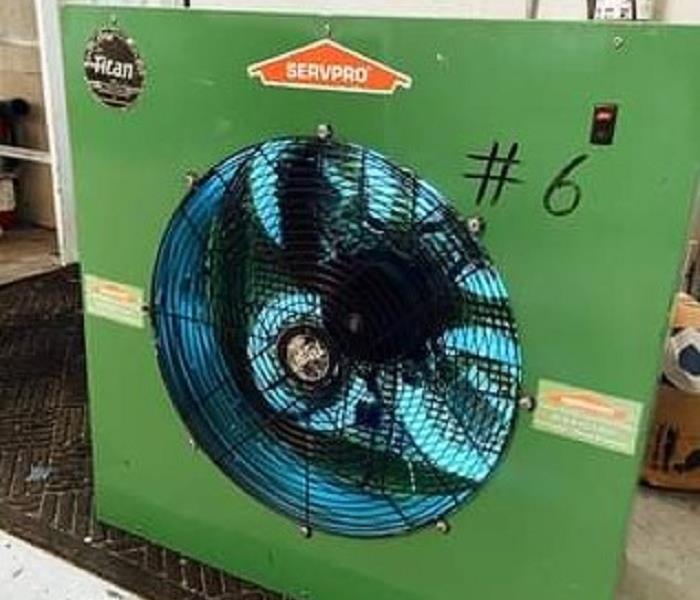 Titan
Titan
Here is a brief summary of one of our most technologically savvy and futuristic looking tools of our SERVPRO of Crescenta Valley / East Glendale tool belt. The Hydroxyl Generator (or more commonly known as ‘Titan’) is one of the most scientifically-advanced pieces of equipment we use to combat malodors and leave a property deodorized following biohazard, fire or water damage events.
The main benefit of using a true hydroxyl generator is that they are safe to use in occupied areas for deodorization purposes. For insurance companies and commercial businesses alike, they love this machine because it means less out of pocket expenses and henceforth, less business disruption!
These generators have been successfully tested on fires and other restoration and bio jobs, including protein fires, floods, dead body situations, skunk odors, pet urine odors, musty odors and many types of odors. However, it’s important to note that hydroxyl generators are not intended for use on mold remediation jobs where there is a large infestation on surfaces or behind walls. The established protocols should always be followed in these instances. But generators with good filtration are excellent for airborne microbial remediation where bacteria or fungi have become aerosolized.
Here’s a rundown of some additional facts in order to give you the inside scoop, should you ever need to reach out to us for smoke/soot deodorization needs:
When to Use:
- When odors, gases and organic pollutants are needed to be remediated
How it Works:
- UVA rays are emitted from the titanium dioxide photocatalytic lamps (wow, that was a mouthful) where they then pass through a permanent anatase coated super reactor screen, forming electron hole pairs that react with water and oxygen in the air to form free electrons and hydroxyl radicals that then decompose and eliminate organic and inorganic gases and air pollutants. Wow, trying saying all that in one breath!
Applications:
- Use on fire and flood damage restoration jobs
- Use to destroy odors from cigarette smoke, dead body, urine, garbage, airborne VOCs and more
Tips:
- Always remove the source of the odor before operation
- For optimum performance, a 60%+ humidity level is best. If needed, place a bucket of water or a wet towel behind the machine to allow more moisture to be pulled into the air stream.
- Use air movers to circulate the air for thorough air cleaning.
- Although purifying an area depends on many variables, a general time guide for purifying a 1,000 cubic foot area with light to moderator odor is 1 to 3 hours.
As always, if you want to learn more about any of our SERVPRO of Crescenta Valley / East Glendale pieces of restoration hardware, feel free to reach out. We have helpful staff willing to explain further any of our services – (818) 790-2021.
Effects of Smoke and Soot
4/6/2022 (Permalink)
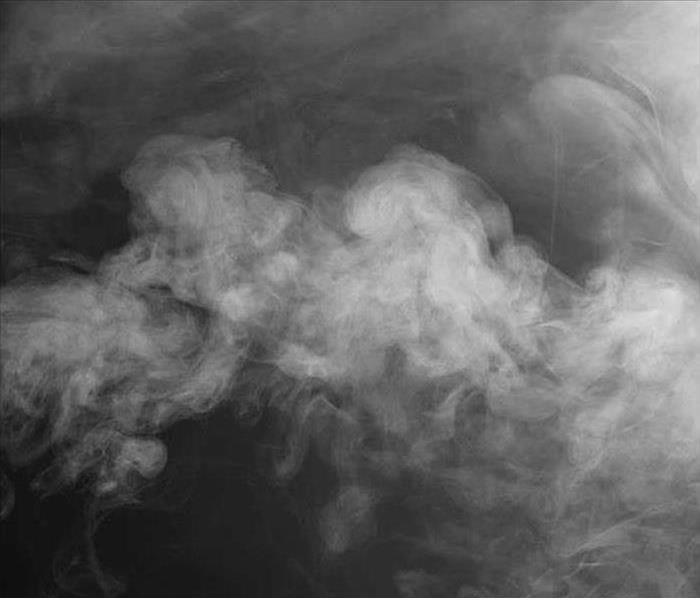 Smoke
Smoke
After experiencing a fire it is clear there are many different types of fire damage that need to be examined. A very important and destructive form of fire damage is the smoke and soot. One reason smoke and soot can be so damaging is the fact the extent of the damage is usually hidden fairly well. Our smoke damage expertise and experience allows us to inspect and accurately assess the extent of the damage to develop a comprehensive plan of action.
Different Types of Smoke:
When it comes to smoke there are two different types of smoke–wet and dry. As a result, there are different types of soot residue after a fire. SERVPRO of Crescenta starts by testing the soot to determine which type of smoke damage occurred. The cleaning procedures will then be based on the information identified during pretesting. Here is some additional information:
Wet Smoke – Plastic and Rubber
- Low heat, smoldering, pungent odor, sticky, smeary. Smoke webs are more difficult to clean.
Dry Smoke – Paper and Wood
- Fast burning, high temperatures, heat rises therefore smoke rises.
Protein Fire Residue – Produced by evaporation of material rather than from a fire
- Virtually invisible, discolors paints and varnishes, extreme pungent odor.
Smoke and soot facts:
To bring some more understanding on how smoke and soot work, here are some facts that could be potentially useful.
- Hot smoke migrates to cooler areas and upper levels of a structure.
- Smoke flows around plumbing systems, seeping through the holes used by pipes to go from floor to floor.
- The type of smoke may greatly affect the restoration process.
Our Fire Damage Restoration Services:
Since each smoke and fire damage situation is a little different, each one requires a unique solution tailored for the specific conditions. We have the equipment, expertise, and experience to restore your fire and smoke damage.
Have Questions about Fire, Smoke, or Soot Damage?
Call Us Today – (818) 842-1400
House Fires in Winter
2/4/2022 (Permalink)
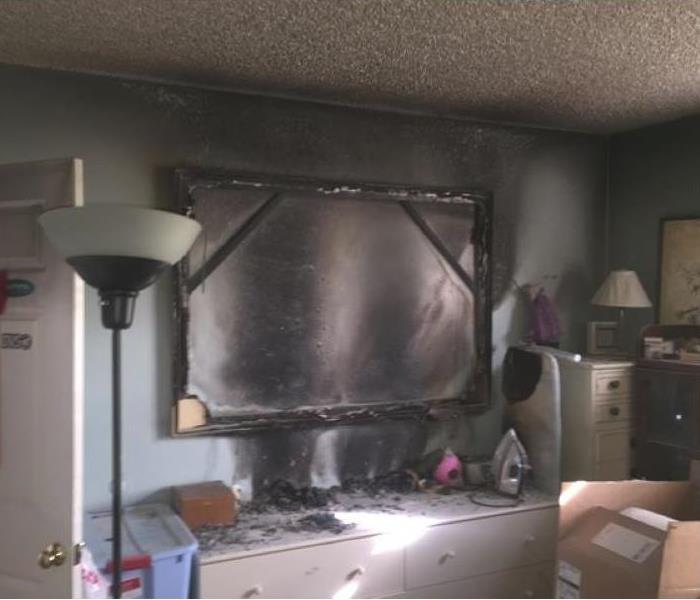 House Fire
House Fire
Did you know that according to the California State Firefighter's Association, December, January, February and March are the peak months for house fires?
The cause of these fires are primarily due to heating equipment such as space heaters. The different ways space heaters can cause a fire are:
- Lack of cleaning around space heaters and/or inside chimneys
- Placing heaters too close to combustibles
- Basic flaws in the design of the heater
- Leaks involving liquid or gas heaters
Here are some ways that you can help prevent winter fires and protect yourself and your family:
Turn off space heaters when leaving a room- Give space heaters at least 3 feet clearance all the way around from household items
- Clean around space heaters regularly, especially inside of the chimney
- Install smoke detectors
- Keep a fire extinguisher in your home and educate yourself on how to use it
Unfortunately, even with precautions fires can still happen in your home. If you do suffer fire or smoke damage in your home, have no fear we are here to help! We have certified trained technicians that specialize in fire and smoke damage. Please call us, SERVPRO of Crescenta Valley/East Glendale (818) 842-1400.
Fire Prevention
10/18/2021 (Permalink)
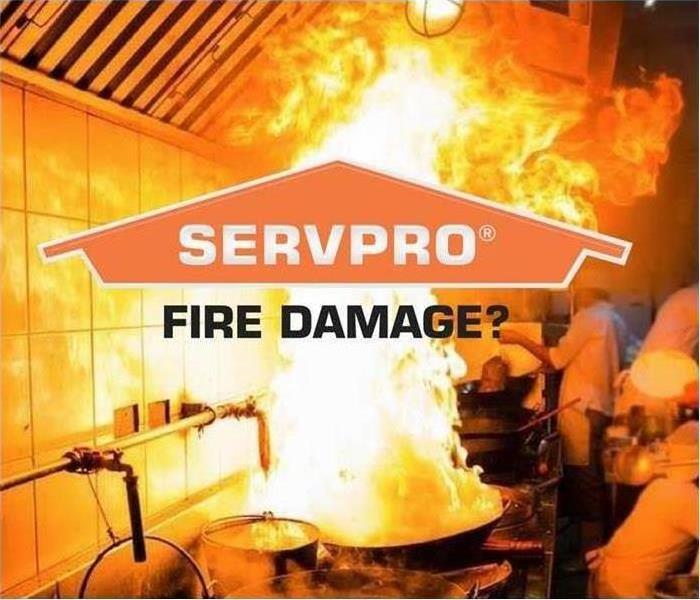 Fire Damage
Fire Damage
Most people know the basics of fire safety at home, such as not leaving burning candles unattended and keeping a fire extinguisher on hand. Here are a few more things you can do to prevent fires at home.
- Have your heating system serviced regularly by a professional.
- Including chimneys from wood-burning fireplaces. Clean around heat sources and keep dust and other flammable items away from ignition sources.
- Remove the lint from your dryer filter after every use.
- A clogged filter and lint trap makes your dryer less efficient, reduces the airflow needed to keep heat from building up in the vents, and forces lint onto the heating coils. Also, never let your dryer run when you are out of the house or when you’re asleep.
- Keep firewood, piles of leaves and trash away from the home.
- If a grass fire starts nearby, these items next to your home could easily become kindling. Never dump hot ashes inside or near your home; keep them in a metal container well away from your house and garage.
- Avoid using outlet extenders or plug-in power bars:
- They can quickly overload an electrical circuit. Replace old, damaged or frayed appliance cords, and never force a three-pronged plug into a two-slot outlet or extension cord.
- Store containers of cooking oil well away from the stove.
- When cooking with oil, never leave the stove unattended. To stop a grease fire, turn off the burner and place a lid on the pan to suffocate the flames, or pour on lots of baking soda. Never pour water on a grease fire or try to carry the pan outside; water splatters the grease and makes the fire bigger, and the pan will be much too hot to carry.
- Consider using borrowed heat to keep outdoor pets warm.
- During winter months, avoid using heat lamps, solar lamps, trouble lights, heated watering bowls or other such heated devices, which could lead to a potential fire. Borrowed heat involves providing warmth from a heating system located in a separate building. If this isn’t possible, consider bringing your pets inside.
- Be sure to properly extinguish smoking materials.
- Smoking materials that are not properly extinguished can smolder undetected for days before igniting a fire. Never discard smoking materials on the ground or in plant pots.
Info provided by: https://www.cooperators.ca/en/Answer-Centre/how-can-i-be-safe-and-prepared/home/five-best-ways-to-prevent-fires-in-home.aspx
Preventing Fires
8/25/2021 (Permalink)
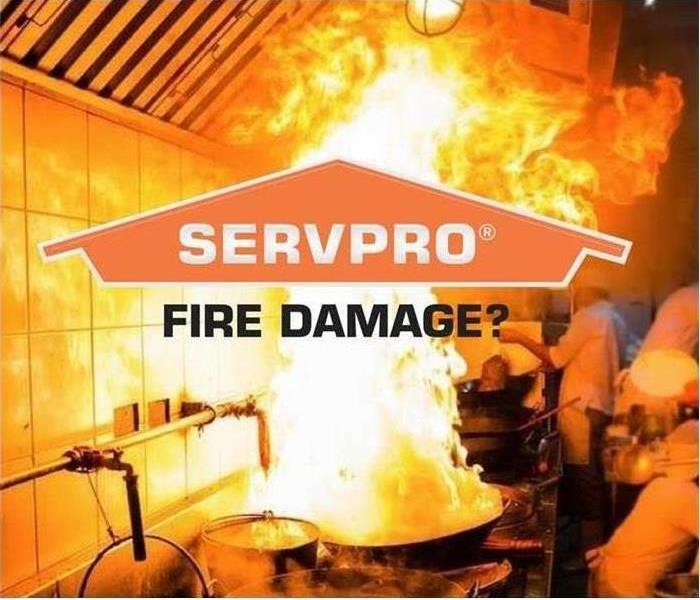 Fire Damage
Fire Damage
Most people know the basics of fire safety at home, such as not leaving burning candles unattended and keeping a fire extinguisher on hand. Here are a few more things you can do to prevent fires at home.
- Have your heating system serviced regularly by a professional.
- Including chimneys from wood-burning fireplaces. Clean around heat sources and keep dust and other flammable items away from ignition sources.
- Remove the lint from your dryer filter after every use.
- A clogged filter and lint trap makes your dryer less efficient, reduces the airflow needed to keep heat from building up in the vents, and forces lint onto the heating coils. Also, never let your dryer run when you are out of the house or when you’re asleep.
- Keep firewood, piles of leaves and trash away from the home.
- If a grass fire starts nearby, these items next to your home could easily become kindling. Never dump hot ashes inside or near your home; keep them in a metal container well away from your house and garage.
- Avoid using outlet extenders or plug-in power bars:
- They can quickly overload an electrical circuit. Replace old, damaged or frayed appliance cords, and never force a three-pronged plug into a two-slot outlet or extension cord.
- Store containers of cooking oil well away from the stove.
- When cooking with oil, never leave the stove unattended. To stop a grease fire, turn off the burner and place a lid on the pan to suffocate the flames, or pour on lots of baking soda. Never pour water on a grease fire or try to carry the pan outside; water splatters the grease and makes the fire bigger, and the pan will be much too hot to carry.
- Consider using borrowed heat to keep outdoor pets warm.
- During winter months, avoid using heat lamps, solar lamps, trouble lights, heated watering bowls or other such heated devices, which could lead to a potential fire. Borrowed heat involves providing warmth from a heating system located in a separate building. If this isn’t possible, consider bringing your pets inside.
- Be sure to properly extinguish smoking materials.
- Smoking materials that are not properly extinguished can smolder undetected for days before igniting a fire. Never discard smoking materials on the ground or in plant pots.
Info provided by: https://www.cooperators.ca/en/Answer-Centre/how-can-i-be-safe-and-prepared/home/five-best-ways-to-prevent-fires-in-home.aspx
Smoke and Soot
8/25/2021 (Permalink)
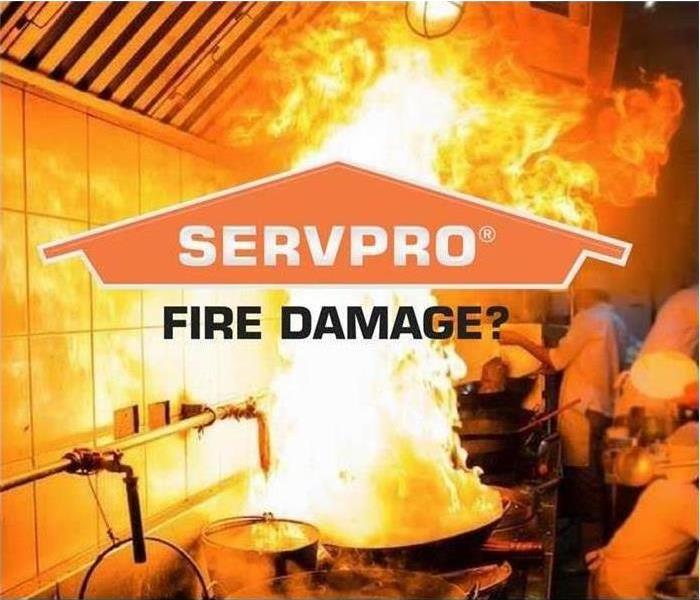 Fire Damage
Fire Damage
After experiencing a fire it is clear there are many different types of fire damage that need to be examined. A very important and destructive form of fire damage is the smoke and soot. One reason smoke and soot can be so damaging is the fact the extent of the damage is usually hidden fairly well. Our smoke damage expertise and experience allows us to inspect and accurately assess the extent of the damage to develop a comprehensive plan of action.
Different Types of Smoke:
When it comes to smoke there are two different types of smoke–wet and dry. As a result, there are different types of soot residue after a fire. SERVPRO of Burbank starts by testing the soot to determine which type of smoke damage occurred. The cleaning procedures will then be based on the information identified during pretesting. Here is some additional information:
Wet Smoke – Plastic and Rubber
- Low heat, smoldering, pungent odor, sticky, smeary. Smoke webs are more difficult to clean.
Dry Smoke – Paper and Wood
- Fast burning, high temperatures, heat rises therefore smoke rises.
Protein Fire Residue – Produced by evaporation of material rather than from a fire
- Virtually invisible, discolors paints and varnishes, extreme pungent odor.
Smoke and soot facts:
To bring some more understanding on how smoke and soot work, here are some facts that could be potentially useful.
- Hot smoke migrates to cooler areas and upper levels of a structure.
- Smoke flows around plumbing systems, seeping through the holes used by pipes to go from floor to floor.
- The type of smoke may greatly affect the restoration process.
Our Fire Damage Restoration Services:
Since each smoke and fire damage situation is a little different, each one requires a unique solution tailored for the specific conditions. We have the equipment, expertise, and experience to restore your fire and smoke damage.
Have Questions about Fire, Smoke, or Soot Damage?
Call Us Today – (818) 842-1400
Hydroxyl Generators
6/17/2021 (Permalink)
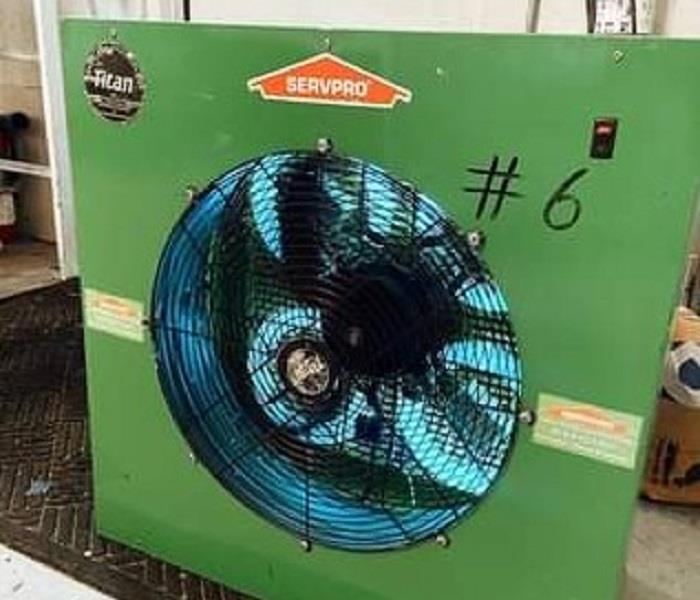 Titan
Titan
Here is a brief summary of one of our most technologically savvy and futuristic looking tools of our SERVPRO of Crescenta Valley / East Glendale tool belt. The Hydroxyl Generator (or more commonly known as ‘Titan’) is one of the most scientifically-advanced pieces of equipment we use to combat malodors and leave a property deodorized following biohazard, fire or water damage events.
The main benefit of using a true hydroxyl generator is that they are safe to use in occupied areas for deodorization purposes. For insurance companies and commercial businesses alike, they love this machine because it means less out of pocket expenses and henceforth, less business disruption!
These generators have been successfully tested on fires and other restoration and bio jobs, including protein fires, floods, dead body situations, skunk odors, pet urine odors, musty odors and many types of odors. However, it’s important to note that hydroxyl generators are not intended for use on mold remediation jobs where there is a large infestation on surfaces or behind walls. The established protocols should always be followed in these instances. But generators with good filtration are excellent for airborne microbial remediation where bacteria or fungi have become aerosolized.
Here’s a rundown of some additional facts in order to give you the inside scoop, should you ever need to reach out to us for smoke/soot deodorization needs:
When to Use:
- When odors, gases and organic pollutants are needed to be remediated
How it Works:
- UVA rays are emitted from the titanium dioxide photocatalytic lamps (wow, that was a mouthful) where they then pass through a permanent anatase coated super reactor screen, forming electron hole pairs that react with water and oxygen in the air to form free electrons and hydroxyl radicals that then decompose and eliminate organic and inorganic gases and air pollutants. Wow, trying saying all that in one breath!
Applications:
- Use on fire and flood damage restoration jobs
- Use to destroy odors from cigarette smoke, dead body, urine, garbage, airborne VOCs and more
Tips:
- Always remove the source of the odor before operation
- For optimum performance, a 60%+ humidity level is best. If needed, place a bucket of water or a wet towel behind the machine to allow more moisture to be pulled into the air stream.
- Use air movers to circulate the air for thorough air cleaning.
- Although purifying an area depends on many variables, a general time guide for purifying a 1,000 cubic foot area with light to moderator odor is 1 to 3 hours.
As always, if you want to learn more about any of our SERVPRO of Crescenta Valley / East Glendale pieces of restoration hardware, feel free to reach out. We have helpful staff willing to explain further any of our services – (818) 790-2021.
Smoke and Soot Effects
4/1/2021 (Permalink)
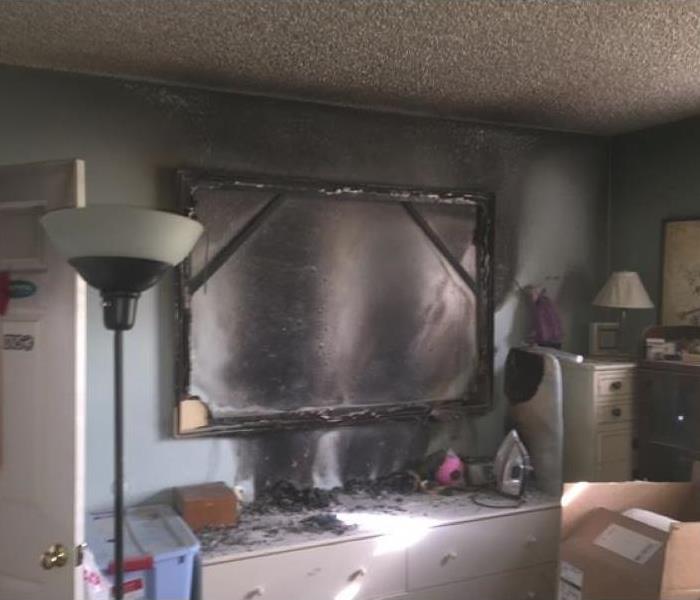 House Fire
House Fire
After experiencing a fire it is clear there are many different types of fire damage that need to be examined. A very important and destructive form of fire damage is the smoke and soot. One reason smoke and soot can be so damaging is the fact the extent of the damage is usually hidden fairly well. Our smoke damage expertise and experience allows us to inspect and accurately assess the extent of the damage to develop a comprehensive plan of action.
Different Types of Smoke:
When it comes to smoke there are two different types of smoke–wet and dry. As a result, there are different types of soot residue after a fire. SERVPRO of Burbank starts by testing the soot to determine which type of smoke damage occurred. The cleaning procedures will then be based on the information identified during pretesting. Here is some additional information:
Wet Smoke – Plastic and Rubber
- Low heat, smoldering, pungent odor, sticky, smeary. Smoke webs are more difficult to clean.
Dry Smoke – Paper and Wood
- Fast burning, high temperatures, heat rises therefore smoke rises.
Protein Fire Residue – Produced by evaporation of material rather than from a fire
- Virtually invisible, discolors paints and varnishes, extreme pungent odor.
Smoke and soot facts:
To bring some more understanding on how smoke and soot work, here are some facts that could be potentially useful.
- Hot smoke migrates to cooler areas and upper levels of a structure.
- Smoke flows around plumbing systems, seeping through the holes used by pipes to go from floor to floor.
- The type of smoke may greatly affect the restoration process.
Our Fire Damage Restoration Services:
Since each smoke and fire damage situation is a little different, each one requires a unique solution tailored for the specific conditions. We have the equipment, expertise, and experience to restore your fire and smoke damage.
Have Questions about Fire, Smoke, or Soot Damage?
Call Us Today – (818) 842-1400
Winter House Fires
2/3/2021 (Permalink)
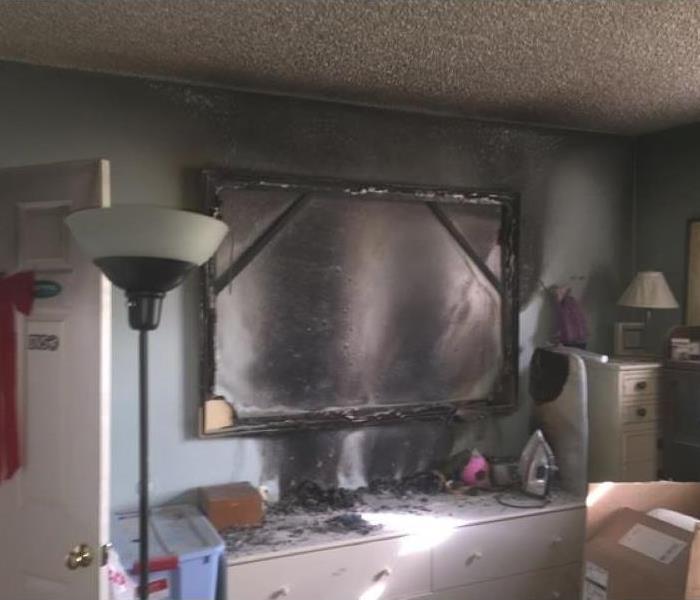 Fire that happened in December
Fire that happened in December
Did you know that according to the California State Firefighter's Association, December, January, February and March are the peak months for house fires?
The cause of these fires are primarily due to heating equipment such as space heaters. The different ways space heaters can cause a fire are:
- Lack of cleaning around space heaters and/or inside chimneys
- Placing heaters too close to combustibles
- Basic flaws in the design of the heater
- Leaks involving liquid or gas heaters
Here are some ways that you can help prevent winter fires and protect yourself and your family:
Turn off space heaters when leaving a room- Give space heaters at least 3 feet clearance all the way around from household items
- Clean around space heaters regularly, especially inside of the chimney
- Install smoke detectors
- Keep a fire extinguisher in your home and educate yourself on how to use it
Unfortunately, even with precautions fires can still happen in your home. If you do suffer fire or smoke damage in your home, have no fear we are here to help! We have certified trained technicians that specialize in fire and smoke damage. Please call us, SERVPRO of Crescenta Valley/East Glendale (818) 842-1400.
Preventing Fires
10/5/2020 (Permalink)
Most people know the basics of fire safety at home, such as not leaving burning candles unattended and keeping a fire extinguisher on hand. Here are a few more things you can do to prevent fires at home.
- Have your heating system serviced regularly by a professional.
- Including chimneys from wood-burning fireplaces. Clean around heat sources and keep dust and other flammable items away from ignition sources.
- Remove the lint from your dryer filter after every use.
- A clogged filter and lint trap makes your dryer less efficient, reduces the airflow needed to keep heat from building up in the vents, and forces lint onto the heating coils. Also, never let your dryer run when you are out of the house or when you’re asleep.
- Keep firewood, piles of leaves and trash away from the home.
- If a grass fire starts nearby, these items next to your home could easily become kindling. Never dump hot ashes inside or near your home; keep them in a metal container well away from your house and garage.
- Avoid using outlet extenders or plug-in power bars:
- They can quickly overload an electrical circuit. Replace old, damaged or frayed appliance cords, and never force a three-pronged plug into a two-slot outlet or extension cord.
- Store containers of cooking oil well away from the stove.
- When cooking with oil, never leave the stove unattended. To stop a grease fire, turn off the burner and place a lid on the pan to suffocate the flames, or pour on lots of baking soda. Never pour water on a grease fire or try to carry the pan outside; water splatters the grease and makes the fire bigger, and the pan will be much too hot to carry.
- Consider using borrowed heat to keep outdoor pets warm.
- During winter months, avoid using heat lamps, solar lamps, trouble lights, heated watering bowls or other such heated devices, which could lead to a potential fire. Borrowed heat involves providing warmth from a heating system located in a separate building. If this isn’t possible, consider bringing your pets inside.
- Be sure to properly extinguish smoking materials.
- Smoking materials that are not properly extinguished can smolder undetected for days before igniting a fire. Never discard smoking materials on the ground or in plant pots.
Info provided by: https://www.cooperators.ca/en/Answer-Centre/how-can-i-be-safe-and-prepared/home/five-best-ways-to-prevent-fires-in-home.aspx
Soot & Smoke Damage
8/17/2020 (Permalink)
After experiencing a fire it is clear there are many different types of fire damage that need to be examined. A very important and destructive form of fire damage is the smoke and soot. One reason smoke and soot can be so damaging is the fact the extent of the damage is usually hidden fairly well. Our smoke damage expertise and experience allows us to inspect and accurately assess the extent of the damage to develop a comprehensive plan of action.
Different Types of Smoke:
When it comes to smoke there are two different types of smoke–wet and dry. As a result, there are different types of soot residue after a fire. SERVPRO of Burbank starts by testing the soot to determine which type of smoke damage occurred. The cleaning procedures will then be based on the information identified during pretesting. Here is some additional information:
Wet Smoke – Plastic and Rubber
- Low heat, smoldering, pungent odor, sticky, smeary. Smoke webs are more difficult to clean.
Dry Smoke – Paper and Wood
- Fast burning, high temperatures, heat rises therefore smoke rises.
Protein Fire Residue – Produced by evaporation of material rather than from a fire
- Virtually invisible, discolors paints and varnishes, extreme pungent odor.
Smoke and soot facts:
To bring some more understanding on how smoke and soot work, here are some facts that could be potentially useful.
- Hot smoke migrates to cooler areas and upper levels of a structure.
- Smoke flows around plumbing systems, seeping through the holes used by pipes to go from floor to floor.
- The type of smoke may greatly affect the restoration process.
Our Fire Damage Restoration Services:
Since each smoke and fire damage situation is a little different, each one requires a unique solution tailored for the specific conditions. We have the equipment, expertise, and experience to restore your fire and smoke damage.
Have Questions about Fire, Smoke, or Soot Damage?
Call Us Today – (818) 842-1400
Fire Prevention
8/17/2020 (Permalink)
Most people know the basics of fire safety at home, such as not leaving burning candles unattended and keeping a fire extinguisher on hand. Here are a few more things you can do to prevent fires at home.
- Have your heating system serviced regularly by a professional.
- including chimneys from wood-burning fireplaces. Clean around heat sources and keep dust and other flammable items away from ignition sources.
- Remove the lint from your dryer filter after every use.
- A clogged filter and lint trap makes your dryer less efficient, reduces the airflow needed to keep heat from building up in the vents, and forces lint onto the heating coils. Also, never let your dryer run when you are out of the house or when you’re asleep.
- Keep firewood, piles of leaves and trash away from the home.
- If a grass fire starts nearby, these items next to your home could easily become kindling. Never dump hot ashes inside or near your home; keep them in a metal container well away from your house and garage.
- Avoid using outlet extenders or plug-in power bars:
- they can quickly overload an electrical circuit. Replace old, damaged or frayed appliance cords, and never force a three-pronged plug into a two-slot outlet or extension cord.
- Store containers of cooking oil well away from the stove.
- When cooking with oil, never leave the stove unattended. To stop a grease fire, turn off the burner and place a lid on the pan to suffocate the flames, or pour on lots of baking soda. Never pour water on a grease fire or try to carry the pan outside; water splatters the grease and makes the fire bigger, and the pan will be much too hot to carry.
- Consider using borrowed heat to keep outdoor pets warm.
- During winter months, avoid using heat lamps, solar lamps, trouble lights, heated watering bowls or other such heated devices, which could lead to a potential fire. Borrowed heat involves providing warmth from a heating system located in a separate building. If this isn’t possible, consider bringing your pets inside.
- Be sure to properly extinguish smoking materials.
- Smoking materials that are not properly extinguished can smolder undetected for days before igniting a fire. Never discard smoking materials on the ground or in plant pots.
Info provided by: https://www.cooperators.ca/en/Answer-Centre/how-can-i-be-safe-and-prepared/home/five-best-ways-to-prevent-fires-in-home.aspx
Hydroxyl Generators
6/12/2020 (Permalink)
For this next round in the ‘SERVPRO Equipment Spotlight’ series, we will be giving a brief summary of one of our most technologically savvy and futuristic looking tools of our SERVPRO of Crescenta Valley / East Glendale tool belt. The Hydroxyl Generator (or more commonly known as ‘Titan’) is one of the most scientifically-advanced pieces of equipment we use to combat malodors and leave a property deodorized following biohazard, fire or water damage events.
The main benefit of using a true hydroxyl generator is that they are safe to use in occupied areas for deodorization purposes. For insurance companies and commercial businesses alike, they love this machine because it means less out of pocket expenses and henceforth, less business disruption!
These generators have been successfully tested on fires and other restoration and bio jobs, including protein fires, floods, dead body situations, skunk odors, pet urine odors, musty odors and many types of odors. However, it’s important to note that hydroxyl generators are not intended for use on mold remediation jobs where there is a large infestation on surfaces or behind walls. The established protocols should always be followed in these instances. But generators with good filtration are excellent for airborne microbial remediation where bacteria or fungi have become aerosolized.
Here’s a rundown of some additional facts in order to give you the inside scoop, should you ever need to reach out to us for smoke/soot deodorization needs:
When to Use:
- When odors, gases and organic pollutants are needed to be remediated
How it Works:
- UVA rays are emitted from the titanium dioxide photocatalytic lamps (wow, that was a mouthful) where they then pass through a permanent anatase coated super reactor screen, forming electron hole pairs that react with water and oxygen in the air to form free electrons and hydroxyl radicals that then decompose and eliminate organic and inorganic gases and air pollutants. Wow, trying saying all that in one breath!
Applications:
- Use on fire and flood damage restoration jobs
- Use to destroy odors from cigarette smoke, dead body, urine, garbage, airborne VOCs and more
Tips:
- Always remove the source of the odor before operation
- For optimum performance, a 60%+ humidity level is best. If needed, place a bucket of water or a wet towel behind the machine to allow more moisture to be pulled into the air stream.
- Use air movers to circulate the air for thorough air cleaning.
- Although purifying an area depends on many variables, a general time guide for purifying a 1,000 cubic foot area with light to moderator odor is 1 to 3 hours.
As always, if you want to learn more about any of our SERVPRO of Crescenta Valley / East Glendale pieces of restoration hardware, feel free to reach out. We have helpful staff willing to explain further any of our services – (818) 790-2021.
The Titan!
3/12/2020 (Permalink)
For this next round in the ‘SERVPRO Equipment Spotlight’ series, we will be giving a brief summary of one of our most technologically savvy and futuristic looking tools of our SERVPRO of Crescenta Valley/East Glendale tool belt. The Hydroxyl Generator (or more commonly known as ‘Titan’) is one of the most scientifically-advanced pieces of equipment we use to combat malodors and leave a property deodorized following biohazard, fire or water damage events.
The main benefit of using a true hydroxyl generator is that they are safe to use in occupied areas for deodorization purposes. For insurance companies and commercial businesses alike, they love this machine because it means less out of pocket expenses and henceforth, less business disruption!
These generators have been successfully tested on fires and other restoration and bio jobs, including protein fires, floods, dead body situations, skunk odors, pet urine odors, musty odors and many types of odors. However, it’s important to note that hydroxyl generators are not intended for use on mold remediation jobs where there is a large infestation on surfaces or behind walls. The established protocols should always be followed in these instances. But generators with good filtration are excellent for airborne microbial remediation where bacteria or fungi have become aerosolized.
Here’s a rundown of some additional facts in order to give you the inside scoop, should you ever need to reach out to us for smoke/soot deodorization needs:
When to Use:
- When odors, gases and organic pollutants are needed to be remediated
How it Works:
- UVA rays are emitted from the titanium dioxide photocatalytic lamps (wow, that was a mouthful) where they then pass through a permanent anatase coated super reactor screen, forming electron hole pairs that react with water and oxygen in the air to form free electrons and hydroxyl radicals that then decompose and eliminate organic and inorganic gases and air pollutants. Wow, trying saying all that in one breath!
Applications:
- Use on fire and flood damage restoration jobs
- Use to destroy odors from cigarette smoke, dead body, urine, garbage, airborne VOCs and more
Tips:
- Always remove the source of the odor before operation
- For optimum performance, a 60%+ humidity level is best. If needed, place a bucket of water or a wet towel behind the machine to allow more moisture to be pulled into the air stream.
- Use air movers to circulate the air for thorough air cleaning.
- Although purifying an area depends on many variables, a general time guide for purifying a 1,000 cubic foot area with light to moderate odor is 1 to 3 hours.
SERVPRO of Crescenta Valley/East Glendale is available 24 hrs a day, 7 days a week.
Call at (818) 842 -1400
Keeping your House Safe
2/3/2020 (Permalink)
Developing Fire Safe Habits For Your Home
- Keep items that can catch on fire at least three feet away from anything that gets hot, such as space heaters.
- Smoking materials are the leading cause of residential fire deaths in the United States. If you smoke, take precautions: Smoke outside; choose fire-safe cigarettes; never smoke in bed, when drowsy or medicated, or if anyone in the home is using oxygen.
- Use deep, sturdy ashtrays and douse cigarette and cigar butts with water before disposal.
- Talk to children regularly about the dangers of fire, matches and lighters and keep them out of reach.
- Turn portable heaters off when you leave the room or go to sleep.
- Never leave a burning candle unattended, even for a minute.
Info provided by redcross.org.
The Effects of Smoke and Soot
8/20/2019 (Permalink)
After experiencing a fire it is clear there are many different types of fire damage that need to be examined. A very important and destructive form of fire damage is the smoke and soot. One reason smoke and soot can be so damaging is the fact the extent of the damage is usually hidden fairly well. Our smoke damage expertise and experience allows us to inspect and accurately assess the extent of the damage to develop a comprehensive plan of action.
Different Types of Smoke:
When it comes to smoke there are two different types of smoke–wet and dry. As a result, there are different types of soot residue after a fire. SERVPRO of Burbank starts by testing the soot to determine which type of smoke damage occurred. The cleaning procedures will then be based on the information identified during pretesting. Here is some additional information:
Wet Smoke – Plastic and Rubber
- Low heat, smoldering, pungent odor, sticky, smeary. Smoke webs are more difficult to clean.
Dry Smoke – Paper and Wood
- Fast burning, high temperatures, heat rises therefore smoke rises.
Protein Fire Residue – Produced by evaporation of material rather than from a fire
- Virtually invisible, discolors paints and varnishes, extreme pungent odor.
Smoke and soot facts:
To bring some more understanding on how smoke and soot work, here are some facts that could be potentially useful.
- Hot smoke migrates to cooler areas and upper levels of a structure.
- Smoke flows around plumbing systems, seeping through the holes used by pipes to go from floor to floor.
- The type of smoke may greatly affect the restoration process.
Our Fire Damage Restoration Services:
Since each smoke and fire damage situation is a little different, each one requires a unique solution tailored for the specific conditions. We have the equipment, expertise, and experience to restore your fire and smoke damage.
Have Questions about Fire, Smoke, or Soot Damage?
Call Us Today – (818) 842-1400
Common Causes of House Fires
8/20/2019 (Permalink)
A house fire may seem uncommon or like it could never actually happen to you. There are several simple and common ways house fires come about. A mistake that may appear small or insignificant could end up being the reason for an accidental fire.
The Top 5 most common causes for house fires and ways to prevent it:
- Cooking equipment: Something as simple as leaving a pot/pan unattended on the stove has been ranked the number one cause of a house fire. Using precautions make sure to keep a close eye on your cooking equipment as to prevent disaster.
- Heaters: To prevent a portable heater fire from starting make sure you keep cloths or any flammable items a good distance away from heaters.
- Smoking: Smoking overall is best kept as an outside thing and especially not a bedroom pastime. Smoking has been known to have a 73% fatality rate among any bedroom house fire.
- Candles: There is no doubt that a good smelling candle is a lovely thing to have going throughout the house. But to prevent any destruction make sure you blow out any candles when leaving the room and keep them all away from any flammable things.
- Curious Children: Children are wonderful and very curious little humans. That is why it is so important to keep things such as lighters and matches out of reach of small hands to prevent any accidents.
In the case of water damage, fire damage, and storm damage, SERVPRO of Crescenta Valley / East Glendale provides “24 Hour Emergency Services.”
Preventing a Fire in Your Home
6/4/2019 (Permalink)
How to prevent fires at home
Most people know the basics of fire safety at home, such as not leaving burning candles unattended and keeping a fire extinguisher on hand. Here are a few more things you can do to prevent fires at home.
- Have your heating system serviced regularly by a professional, including chimneys from wood-burning fireplaces. Clean around heat sources and keep dust and other flammable items away from ignition sources.
- Remove the lint from your dryer filter after every use. A clogged filter and lint trap makes your dryer less efficient, reduces the airflow needed to keep heat from building up in the vents, and forces lint onto the heating coils. Also, never let your dryer run when you are out of the house or when you’re asleep.
- Keep firewood, piles of leaves and trash away from the home. If a grass fire starts nearby, these items next to your home could easily become kindling. Never dump hot ashes inside or near your home; keep them in a metal container well away from your house and garage.
- Avoid using outlet extenders or plug-in power bars: they can quickly overload an electrical circuit. Replace old, damaged or frayed appliance cords, and never force a three-pronged plug into a two-slot outlet or extension cord.
- Store containers of cooking oil well away from the stove. When cooking with oil, never leave the stove unattended. To stop a grease fire, turn off the burner and place a lid on the pan to suffocate the flames, or pour on lots of baking soda. Never pour water on a grease fire or try to carry the pan outside; water splatters the grease and makes the fire bigger, and the pan will be much too hot to carry.
- Consider using borrowed heat to keep outdoor pets warm. During winter months, avoid using heat lamps, solar lamps, trouble lights, heated watering bowls or other such heated devices, which could lead to a potential fire. Borrowed heat involves providing warmth from a heating system located in a separate building. If this isn’t possible, consider bringing your pets inside.
- Be sure to properly extinguish smoking materials. Smoking materials that are not properly extinguished can smoulder undetected for days before igniting a fire. Never discard smoking materials on the ground or in plant pots.
info provided by https://www.cooperators.ca/en/Answer-Centre/how-can-i-be-safe-and-prepared/home/five-best-ways-to-prevent-fires-in-home.aspx
Titan
3/12/2019 (Permalink)
For this next round in the ‘SERVPRO Equipment Spotlight’ series, we will be giving a brief summary of one of our most technologically savvy and futuristic looking tools of our SERVPRO tool belt. The Hydroxyl Generator (or more commonly known as ‘Titan’) is one of the most scientifically-advanced pieces of equipment we use to combat malodors and leave a property deodorized following biohazard, fire or water damage events.
The main benefit of using a true hydroxyl generator is that they are safe to use in occupied areas for deodorization purposes. For insurance companies and commercial businesses alike, they love this machine because it means less out of pocket expenses and henceforth, less business disruption!
These generators have been successfully tested on fires and other restoration and bio jobs, including protein fires, floods, dead body situations, skunk odors, pet urine odors, musty odors and many types of odors. However, it’s important to note that hydroxyl generators are not intended for use on mold remediation jobs where there is a large infestation on surfaces or behind walls. The established protocols should always be followed in these instances. But generators with good filtration are excellent for airborne microbial remediation where bacteria or fungi have become aerosolized.
Here’s a rundown of some additional facts in order to give you the inside scoop, should you ever need to reach out to us for smoke/soot deodorization needs:
When to Use:
- When odors, gases and organic pollutants are needed to be remediated
How it Works:
- UVA rays are emitted from the titanium dioxide photocatalytic lamps (wow, that was a mouthful) where they then pass through a permanent anatase coated super reactor screen, forming electron hole pairs that react with water and oxygen in the air to form free electrons and hydroxyl radicals that then decompose and eliminate organic and inorganic gases and air pollutants. Wow, trying saying all that in one breath!
Applications:
- Use on fire and flood damage restoration jobs
- Use to destroy odors from cigarette smoke, dead body, urine, garbage, airborne VOCs and more
Tips:
- Always remove the source of the odor before operation
- For optimum performance, a 60%+ humidity level is best. If needed, place a bucket of water or a wet towel behind the machine to allow more moisture to be pulled into the air stream.
- Use air movers to circulate the air for thorough air cleaning.
- Although purifying an area depends on many variables, a general time guide for purifying a 1,000 cubic foot area with light to moderator odor is 1 to 3 hours.
As always, if you want to learn more about any of our SERVPRO of Crescenta Valley / East Glendale pieces of restoration hardware, feel free to reach out. We have helpful staff willing to explain further any of our services – (818) 842-1400.
Avoid A Dryer Fire
2/1/2019 (Permalink)
Do you have a dryer? Of course you do. One of the most needed appliances in our homes can also cause the most damage if not taken care of properly. The fear of a dryer fire is one that is not commonly heard of, however, according to the U.S. Consumer Product Safety Commission, there are an estimated annual 15,500 fires, 10 deaths and 10 injuries due to clothes dryer fires. Several hundred people a year are also subjected to carbon monoxide poisoning from improper dryer vent setups. The financial costs come to nearly $100,000,000 per year. In some cases faulty appliances are to blame, but many fires can be prevented with proper dryer venting.
Here are some small steps to take to Avoid a Dryer Fire:
1. Dryer's produce large amounts of lint. Be sure to clean the lint trap after EVERY use of the dryer.
2. Dryer Vents should ONLY be made of metal and be short and straight. Bends and curves result in lint buildup increasing the risk of a fire.
3. Do not run the dryer when you are away from home or sleeping.
SERVPRO of Crescenta Valley / East Glendale is faster to any size disaster
818-842-1400
Have a Safe Superbowl
2/1/2019 (Permalink)
Next to Thanksgiving and Christmas, this upcoming [unofficial] holiday is one of the most anticipated events of the year! We at SERVPRO of Crescenta Valley / East Glendale are huge Super Bowl fans and although any of our technicians would throw down a dozen or so Buffalo wings like it’s nobody’s business, we have crews standing by in case your Super Bowl party gets a little too carried away. According to the U.S. Department of Agriculture, Super Bowl Sunday is the second largest day for food consumption in the U.S. after Thanksgiving. Enjoy the big game and stay fire safe with these tips from the U.S. Fire Administration (USFA):
- Keep an eye on what you fry.
- Stand by your pan.
- Turn pot handles toward the back of the stove.
- Wear short sleeves or rolled up sleeves.
- Keep a pan lid or cookie sheet nearby to cover the pan if it catches fire.
We at SERVPRO have put together a helpful demonstration to raise awareness to kitchen fire, the leading cause of home fires annually. Click the YouTube link below to enjoy!
https://www.youtube.com/watch?v=TTid1Dky2C8
Prepare for Fire Season
10/24/2018 (Permalink)
Here are some things you can do to ‘harden’ your home and commercial building and make it more fire resistant.
Well, we’re at it again folks! Fire season has come blazin’ back this year and with the few that have crept up a little too close for comfort, we wanted to jump in and do our part to help ready our online community with some helpful pointers. That way, you can be rest assured in knowing that you’re ‘as prepared as possible’ to weather the next wildfire that breaks out.
As a Fire & Water Restoration Company who works in people’s homes and office’s following wildfire damage, we hear all the time, “If I had only been prepared…” or “I never would have thought this would happen to me.” We wanted to pass along some practical preventive tips we picked up from The National Interagency Fire Center, a frontrunner in wildfire preparation.
- Use Fire Resistant Building Material - "The Best Thing
That You Can Do"
The roof and exterior structure of your dwelling should be constructed of non-combustible or fire resistant materials such as fire resistant roofing materials, tile, slate, sheet iron, aluminum, brick, or stone. Wood siding, cedar shakes, exterior wood paneling, and other highly combustible materials should be treated with fire retardant chemicals.
- Maintain a Survivable Space - "Things You Can Do Today"
- Clean roof surfaces and gutters of pine needles, leaves, branches, etc., regularly to avoid accumulation of flammable materials.
- Remove portions of any tree extending within 10 feet of the flue opening of any stove or chimney.
- Maintain a screen constructed of non-flammable material over the flue opening of every chimney or stovepipe. Mesh openings of the screen should not exceed 1/2 inch.
- Landscape vegetation should be spaced so that fire cannot be carried to the structure or surrounding vegetation.
- Remove branches from trees to height of 15 feet.
- A fuel break should be maintained around all structures.
- Dispose of stove or fireplace ashes and charcoal briquettes only after soaking them in a metal pail of water.
- Store gasoline in an approved safety can away from occupied buildings.
- Propane tanks should be far enough away from buildings for valves to be shut off in case of fire. Keep area clear of flammable vegetation.
- All combustibles such as firewood, picnic tables, boats, etc. should be kept away from structures.
- Garden hose should be connected to outlet.
- Addressing should be indicated at all intersections and on structures.
- All roads and driveways should be at least 16 feet in width.
- Have fire tools handy such as: ladder long enough to reach the roof, shovel, rake and bucket for water.
- Each home should have at least two different entrance and exit routes.
To learn more on the topic of Fire Preparedness and Prevention in California, visit the Cal Fire’s website for further resources –http://www.readyforwildfire.org/Hardening-Your-Home/
Soot or Smoke Damage?
8/9/2018 (Permalink)
Smoke and soot is very invasive and can penetrate various cavities within your home, causing hidden damage and odor. Our smoke damage expertise and experience allows us to inspect and accurately assess the extent of the damage to develop a comprehensive plan of action.
Smoke and soot facts:
· Hot smoke migrates to cooler areas and upper levels of a structure.
· Smoke flows around plumbing systems, seeping through the holes used by pipes to go from floor to floor.
· The type of smoke may greatly affect the restoration process.
Different Types of Smoke
There are two different types of smoke–wet and dry. As a result, there are different types of soot residue after a fire. Before restoration begins, SERVPRO of Burbank will test the soot to determine which type of smoke damage occurred. The cleaning procedures will then be based on the information identified during pretesting. Here is some additional information:
Wet Smoke – Plastic and Rubber
· Low heat, smoldering, pungent odor, sticky, smeary. Smoke webs are more difficult to clean.
Dry Smoke – Paper and Wood
· Fast burning, high temperatures, heat rises therefore smoke rises.
Protein Fire Residue – Produced by evaporation of material rather than from a fire
· Virtually invisible, discolors paints and varnishes, extreme pungent odor.
Our Fire Damage Restoration Services
Since each smoke and fire damage situation is a little different, each one requires a unique solution tailored for the specific conditions. We have the equipment, expertise, and experience to restore your fire and smoke damage. We will also treat your family with empathy and respect and your property with care.
Have Questions about Fire, Smoke, or Soot Damage?
Call Us Today – (818) 842-1400
Fire Safe Habits
7/31/2018 (Permalink)
Developing Fire Safe Habits For Your Home is very important here in SoCal. SERVPRO of Crescenta Valley / East Glendale and the Red Cross have some tips on how to do so:
- Keep items that can catch on fire at least three feet away from anything that gets hot, such as space heaters.
- Smoking materials are the leading cause of residential fire deaths in the United States. If you smoke, take precautions: Smoke outside; choose fire-safe cigarettes; never smoke in bed, when drowsy or medicated, or if anyone in the home is using oxygen.
- Use deep, sturdy ashtrays and douse cigarette and cigar butts with water before disposal.
- Talk to children regularly about the dangers of fire, matches and lighters and keep them out of reach.
- Turn portable heaters off when you leave the room or go to sleep.
- Never leave a burning candle unattended, even for a minute.
info provide by redcross.org
Preventing Home Fires
6/4/2018 (Permalink)
6/4/2018
How to prevent fires at home
Most people know the basics of fire safety at home, such as not leaving burning candles unattended and keeping a fire extinguisher on hand. Here are a few more things you can do to prevent fires at home.
- Have your heating system serviced regularly by a professional, including chimneys from wood-burning fireplaces. Clean around heat sources and keep dust and other flammable items away from ignition sources.
- Remove the lint from your dryer filter after every use. A clogged filter and lint trap makes your dryer less efficient, reduces the airflow needed to keep heat from building up in the vents, and forces lint onto the heating coils. Also, never let your dryer run when you are out of the house or when you’re asleep.
- Keep firewood, piles of leaves and trash away from the home. If a grass fire starts nearby, these items next to your home could easily become kindling. Never dump hot ashes inside or near your home; keep them in a metal container well away from your house and garage.
- Avoid using outlet extenders or plug-in power bars: they can quickly overload an electrical circuit. Replace old, damaged or frayed appliance cords, and never force a three-pronged plug into a two-slot outlet or extension cord.
- Store containers of cooking oil well away from the stove. When cooking with oil, never leave the stove unattended. To stop a grease fire, turn off the burner and place a lid on the pan to suffocate the flames, or pour on lots of baking soda. Never pour water on a grease fire or try to carry the pan outside; water splatters the grease and makes the fire bigger, and the pan will be much too hot to carry.
- Consider using borrowed heat to keep outdoor pets warm. During winter months, avoid using heat lamps, solar lamps, trouble lights, heated watering bowls or other such heated devices, which could lead to a potential fire. Borrowed heat involves providing warmth from a heating system located in a separate building. If this isn’t possible, consider bringing your pets inside.
- Be sure to properly extinguish smoking materials. Smoking materials that are not properly extinguished can smoulder undetected for days before igniting a fire. Never discard smoking materials on the ground or in plant pots.
info provided by https://www.cooperators.ca/en/Answer-Centre/how-can-i-be-safe-and-prepared/home/five-best-ways-to-prevent-fires-in-home.aspx
The Titan
3/13/2018 (Permalink)
For this next round in the ‘SERVPRO Equipment Spotlight’ series, we will be giving a brief summary of one of our most technologically savvy and futuristic looking tools of our SERVPRO of Crescenta Valley / East Glendale tool belt. The Hydroxyl Generator (or more commonly known as ‘Titan’) is one of the most scientifically-advanced pieces of equipment we use to combat malodors and leave a property deodorized following biohazard, fire or water damage events.
The main benefit of using a true hydroxyl generator is that they are safe to use in occupied areas for deodorization purposes. For insurance companies and commercial businesses alike, they love this machine because it means less out of pocket expenses and henceforth, less business disruption!
These generators have been successfully tested on fires and other restoration and bio jobs, including protein fires, floods, dead body situations, skunk odors, pet urine odors, musty odors and many types of odors. However, it’s important to note that hydroxyl generators are not intended for use on mold remediation jobs where there is a large infestation on surfaces or behind walls. The established protocols should always be followed in these instances. But generators with good filtration are excellent for airborne microbial remediation where bacteria or fungi have become aerosolized.
Here’s a rundown of some additional facts in order to give you the inside scoop, should you ever need to reach out to us for smoke/soot deodorization needs:
When to Use:
- When odors, gases and organic pollutants are needed to be remediated
How it Works:
- UVA rays are emitted from the titanium dioxide photocatalytic lamps (wow, that was a mouthful) where they then pass through a permanent anatase coated super reactor screen, forming electron hole pairs that react with water and oxygen in the air to form free electrons and hydroxyl radicals that then decompose and eliminate organic and inorganic gases and air pollutants. Wow, trying saying all that in one breath!
Applications:
- Use on fire and flood damage restoration jobs
- Use to destroy odors from cigarette smoke, dead body, urine, garbage, airborne VOCs and more
Tips:
- Always remove the source of the odor before operation
- For optimum performance, a 60%+ humidity level is best. If needed, place a bucket of water or a wet towel behind the machine to allow more moisture to be pulled into the air stream.
- Use air movers to circulate the air for thorough air cleaning.
- Although purifying an area depends on many variables, a general time guide for purifying a 1,000 cubic foot area with light to moderator odor is 1 to 3 hours.
As always, if you want to learn more about any of our SERVPRO pieces of restoration hardware, feel free to reach out. We have helpful staff willing to explain further any of our services – (818) 842-1400.
Safe Super Bowl Tips
2/2/2018 (Permalink)
Next to Thanksgiving and Christmas, this upcoming [unofficial] holiday is one of the most anticipated events of the year! We at SERVPRO of Crescenta Valley / East Glendale are huge Super Bowl fans and although any of our technicians would throw down a dozen or so Buffalo wings like it’s nobody’s business, we have crews standing by in case your Super Bowl party gets a little too carried away. According to the U.S. Department of Agriculture, Super Bowl Sunday is the second largest day for food consumption in the U.S. after Thanksgiving. Enjoy the big game and stay fire safe with these tips from the U.S. Fire Administration (USFA):
- Keep an eye on what you fry.
- Stand by your pan.
- Turn pot handles toward the back of the stove.
- Wear short sleeves or rolled up sleeves.
- Keep a pan lid or cookie sheet nearby to cover the pan if it catches fire.
We at SERVPRO have put together a helpful demonstration to raise awareness to kitchen fire, the leading cause of home fires annually. Click the YouTube link below to enjoy!
https://www.youtube.com/watch?v=TTid1Dky2C8
Avoiding a Dryer Fire
1/31/2018 (Permalink)
The fear of a dryer fire is one that is not commonly heard of, however, according to the U.S. Consumer Product Safety Commission, there are an estimated annual 15,500 fires, 10 deaths and 10 injuries due to clothes dryer fires. Several hundred people a year are also subjected to carbon monoxide poisoning from improper dryer vent setups. The financial costs come to nearly $100,000,000 per year. In some cases faulty appliances are to blame, but many fires can be prevented with proper dryer venting.
Here are some small steps to take to Avoid a Dryer Fire:
1. Dryer's produce large amounts of lint. Be sure to clean the lint trap after EVERY use of the dryer.
2. Dryer Vents should ONLY be made of metal and be short and straight. Bends and curves result in lint buildup increasing the risk of a fire.
3. Do not run the dryer when you are away from home or sleeping.
SERVPRO of Crescenta Valley/ East Glendale is faster to any size disaster
818-842-1400
Preparing your Home or Business for Fire Season
10/25/2017 (Permalink)
Here are some things you can do to ‘harden’ your home and commercial building and make it more fire resistant.
Well, we’re at it again folks! Fire season has come blazin’ back this year and with the few that have crept up a little too close for comfort, we wanted to jump in and do our part to help ready our online community with some helpful pointers. That way, you can be rest assured in knowing that you’re ‘as prepared as possible’ to weather the next wildfire that breaks out.
As a Fire & Water Restoration Company who works in people’s homes and office’s following wildfire damage, we hear all the time, “If I had only been prepared…” or “I never would have thought this would happen to me.” We wanted to pass along some practical preventive tips we picked up from The National Interagency Fire Center, a frontrunner in wildfire preparation.
- Use Fire Resistant Building Material - "The Best Thing
That You Can Do"
The roof and exterior structure of your dwelling should be constructed of non-combustible or fire resistant materials such as fire resistant roofing materials, tile, slate, sheet iron, aluminum, brick, or stone. Wood siding, cedar shakes, exterior wood paneling, and other highly combustible materials should be treated with fire retardant chemicals.
- Maintain a Survivable Space - "Things You Can Do Today"
- Clean roof surfaces and gutters of pine needles, leaves, branches, etc., regularly to avoid accumulation of flammable materials.
- Remove portions of any tree extending within 10 feet of the flue opening of any stove or chimney.
- Maintain a screen constructed of non-flammable material over the flue opening of every chimney or stovepipe. Mesh openings of the screen should not exceed 1/2 inch.
- Landscape vegetation should be spaced so that fire cannot be carried to the structure or surrounding vegetation.
- Remove branches from trees to height of 15 feet.
- A fuel break should be maintained around all structures.
- Dispose of stove or fireplace ashes and charcoal briquettes only after soaking them in a metal pail of water.
- Store gasoline in an approved safety can away from occupied buildings.
- Propane tanks should be far enough away from buildings for valves to be shut off in case of fire. Keep area clear of flammable vegetation.
- All combustibles such as firewood, picnic tables, boats, etc. should be kept away from structures.
- Garden hose should be connected to outlet.
- Addressing should be indicated at all intersections and on structures.
- All roads and driveways should be at least 16 feet in width.
- Have fire tools handy such as: ladder long enough to reach the roof, shovel, rake and bucket for water.
- Each home should have at least two different entrance and exit routes.
To learn more on the topic of Fire Preparedness and Prevention in California, visit the Cal Fire’s website for further resources –
http://www.readyforwildfire.org/Hardening-Your-Home/
What is Soot/Smoke Damage?
8/8/2017 (Permalink)
Smoke and soot is very invasive and can penetrate various cavities within your home, causing hidden damage and odor. Our smoke damage expertise and experience allows us to inspect and accurately assess the extent of the damage to develop a comprehensive plan of action.
Smoke and soot facts:
· Hot smoke migrates to cooler areas and upper levels of a structure.
· Smoke flows around plumbing systems, seeping through the holes used by pipes to go from floor to floor.
· The type of smoke may greatly affect the restoration process.
Different Types of Smoke
There are two different types of smoke–wet and dry. As a result, there are different types of soot residue after a fire. Before restoration begins, SERVPRO of Crescenta Valley/East Glendale will test the soot to determine which type of smoke damage occurred. The cleaning procedures will then be based on the information identified during pretesting. Here is some additional information:
Wet Smoke – Plastic and Rubber
· Low heat, smoldering, pungent odor, sticky, smeary. Smoke webs are more difficult to clean.
Dry Smoke – Paper and Wood
· Fast burning, high temperatures, heat rises therefore smoke rises.
Protein Fire Residue – Produced by evaporation of material rather than from a fire
· Virtually invisible, discolors paints and varnishes, extreme pungent odor.
Our Fire Damage Restoration Services
Since each smoke and fire damage situation is a little different, each one requires a unique solution tailored for the specific conditions. We have the equipment, expertise, and experience to restore your fire and smoke damage. We will also treat your family with empathy and respect and your property with care.
Have Questions about Fire, Smoke, or Soot Damage?
Call Us Today – (818) 842-1400
Developing Fire Safe Habits for Your Home
7/25/2017 (Permalink)
Developing Fire Safe Habits For Your Home
- Keep items that can catch on fire at least three feet away from anything that gets hot, such as space heaters.
- Smoking materials are the leading cause of residential fire deaths in the United States. If you smoke, take precautions: Smoke outside; choose fire-safe cigarettes; never smoke in bed, when drowsy or medicated, or if anyone in the home is using oxygen.
- Use deep, sturdy ashtrays and douse cigarette and cigar butts with water before disposal.
- Talk to children regularly about the dangers of fire, matches and lighters and keep them out of reach.
- Turn portable heaters off when you leave the room or go to sleep.
- Never leave a burning candle unattended, even for a minute.
info provide by redcross.org
Preventing Fires in Your Home
6/8/2017 (Permalink)
How to prevent fires at home
Most people know the basics of fire safety at home, such as not leaving burning candles unattended and keeping a fire extinguisher on hand. Here are a few more things you can do to prevent fires at home.
- Have your heating system serviced regularly by a professional, including chimneys from wood-burning fireplaces. Clean around heat sources and keep dust and other flammable items away from ignition sources.
- Remove the lint from your dryer filter after every use. A clogged filter and lint trap makes your dryer less efficient, reduces the airflow needed to keep heat from building up in the vents, and forces lint onto the heating coils. Also, never let your dryer run when you are out of the house or when you’re asleep.
- Keep firewood, piles of leaves and trash away from the home. If a grass fire starts nearby, these items next to your home could easily become kindling. Never dump hot ashes inside or near your home; keep them in a metal container well away from your house and garage.
- Avoid using outlet extenders or plug-in power bars: they can quickly overload an electrical circuit. Replace old, damaged or frayed appliance cords, and never force a three-pronged plug into a two-slot outlet or extension cord.
- Store containers of cooking oil well away from the stove. When cooking with oil, never leave the stove unattended. To stop a grease fire, turn off the burner and place a lid on the pan to suffocate the flames, or pour on lots of baking soda. Never pour water on a grease fire or try to carry the pan outside; water splatters the grease and makes the fire bigger, and the pan will be much too hot to carry.
- Consider using borrowed heat to keep outdoor pets warm. During winter months, avoid using heat lamps, solar lamps, trouble lights, heated watering bowls or other such heated devices, which could lead to a potential fire. Borrowed heat involves providing warmth from a heating system located in a separate building. If this isn’t possible, consider bringing your pets inside.
- Be sure to properly extinguish smoking materials. Smoking materials that are not properly extinguished can smoulder undetected for days before igniting a fire. Never discard smoking materials on the ground or in plant pots.
info provided by: https://www.cooperators.ca/en/Answer-Centre/how-can-i-be-safe-and-prepared/home/five-best-ways-to-prevent-fires-in-home.aspx
5 Steps to Cooking a Safe Super Bowl Feast
2/3/2017 (Permalink)
Next to Thanksgiving and Christmas, this upcoming [unofficial] holiday is one of the most anticipated events of the year! We at SERVPRO of Crescenta Valley / East Glendale are huge Super Bowl fans and although any of our technicians would throw down a dozen or so Buffalo wings like it’s nobody’s business, we have crews standing by in case your Super Bowl party gets a little too carried away. According to the U.S. Department of Agriculture, Super Bowl Sunday is the second largest day for food consumption in the U.S. after Thanksgiving. Enjoy the big game and stay fire safe with these tips from the U.S. Fire Administration (USFA):
- Keep an eye on what you fry.
- Stand by your pan.
- Turn pot handles toward the back of the stove.
- Wear short sleeves or rolled up sleeves.
- Keep a pan lid or cookie sheet nearby to cover the pan if it catches fire.
We at SERVPRO have put together a helpful demonstration to raise awareness to kitchen fire, the leading cause of home fires annually. Click the YouTube link below to enjoy!
https://www.youtube.com/watch?v=TTid1Dky2C8
Preventing Holiday Fires
11/4/2016 (Permalink)
Residential fires during the holiday season are more frequent, more costly, and more deadly than at any other time of the year. The U.S. Fire Administration (USFA) reports more than double the number of open-flame fires on Christmas Day than on an average day, and about twice as many on New Year’s Day. And when those fires occur, they do more damage: Property loss during a holiday fire is 34% greater than in an average fire, and the number of fatalities per thousand fires is nearly 70% higher. When the source of the fire is a highly flammable Christmas tree, the toll in property and lives is even greater.
To keep your household from becoming a holiday fire statistic, here are some safety tips to follow.
Cooking
Cooking is the top cause of holiday fires, according to the USFA. The most common culprit is food that’s left unattended. It’s easy to get distracted; take a pot holder with you when you leave the kitchen as a reminder that you have something on the stove. Make sure to keep a kitchen fire extinguisher that’s rated for all types of fires, and check that smoke detectors are working.
If you’re planning to deep-fry your holiday turkey, do it outside, on a flat, level surface at least 10 feet from the house.
Candles
The incidence of candle fires is four times higher during December than during other months. According to the National Fire Protection Association, four of the five most dangerous days of the year for residential candle fires are Christmas/Christmas Eve and New Year’s/New Year’s Eve. (The fifth is Halloween.)
To reduce the danger, maintain about a foot of space between the candle and anything that can burn. Set candles on sturdy bases or cover with hurricane globes. Never leave flames unattended. Before bed, walk through each room to make sure candles are blown out. For atmosphere without worry, consider flameless LED candles.
Christmas Trees
It takes less than 30 seconds for a dry tree to engulf a room in flames, according to the Building and Fire Research Laboratory of the National Institute for Standards and Technology. “They make turpentine out of pine trees,” notes Tom Olshanski, spokesman for the USFA. “A Christmas tree is almost explosive when it goes.”
To minimize risk, buy a fresh tree with intact needles, get a fresh cut on the trunk, and water it every day. A well-watered tree is almost impossible to ignite. Keep the tree away from heat sources, such as a fireplace or radiator, and out of traffic patterns. If you’re using live garlands and other greenery, keep them at least three feet away from heating sources.
No matter how well the tree is watered, it will start to dry out after about four weeks, Olshanski says, so take it down after the holidays. Artificial trees don’t pose much of a fire hazard; just make sure yours is flame-retardant.
Decorative Lights
Inspect light strings, and throw out any with frayed or cracked wires or broken sockets. When decorating, don’t run more than three strings of lights end to end. “Stacking the plugs is much safer when you’re using a large quantity of lights,” explains Brian L. Vogt, director of education for holiday lighting firm Christmas Décor. Extension cords should be in good condition and UL-rated for indoor or outdoor use. Check outdoor receptacles to make sure the ground fault interrupters don’t trip. If they trip repeatedly, Vogt says, that’s a sign that they need to be replaced.
When hanging lights outside, avoid using nails or staples, which can damage the wiring and increase the risk of a fire. Instead, use UL-rated clips or hangers. And take lights down within 90 days, says John Drengenberg, director of consumer safety for Underwriters Laboratories. “If you leave them up all year round, squirrels chew on them and they get damaged by weather.”
Kids Playing with Matches
The number of blazes — and, tragically, the number of deaths — caused by children playing with fire goes up significantly during the holidays. From January through March, 13% of fire deaths are the result of children playing with fire, the USFA reports; in December, that percentage doubles. So keep matches and lighters out of kids’ reach. “We tend to underestimate the power of these tools,” says Meri-K Appy, president of the nonprofit Home Safety Council. “A match or lighter could be more deadly than a loaded gun in the hands of a small child.”
Fireplaces
Soot can harden on chimney walls as flammable creosote, so before the fireplace season begins, have your chimney inspected to see if it needs cleaning. Screen the fireplace to prevent embers from popping out onto the floor or carpet, and never use flammable liquids to start a fire in the fireplace. Only burn seasoned wood — no wrapping paper.
When cleaning out the fireplace, put embers in a metal container and set them outside to cool for 24 hours before disposal.
info provided by: https://www.houselogic.com/home-thoughts/holiday-fire-safety-tips/
Preparing your Crescenta Valley / East Glendale Home or Business for Fire Season
8/9/2016 (Permalink)
Here are some things you can do to ‘harden’ your home and commercial building and make it more fire resistant.
Well, we’re at it again folks! Fire season has come blazin’ back this year and with the few that have crept up a little too close for comfort, we wanted to jump in and do our part to help ready our online community with some helpful pointers. That way, you can be rest assured in knowing that you’re ‘as prepared as possible’ to weather the next wildfire that breaks out.
As a Fire & Water Restoration Company who works in people’s homes and office’s following wildfire damage, we hear all the time, “If I had only been prepared…” or “I never would have thought this would happen to me.” We wanted to pass along some practical preventive tips we picked up from The National Interagency Fire Center, a frontrunner in wildfire preparation.
Use Fire Resistant Building Material - "The Best Thing
That You Can Do"
The roof and exterior structure of your dwelling should be constructed of non-combustible or fire resistant materials such as fire resistant roofing materials, tile, slate, sheet iron, aluminum, brick, or stone. Wood siding, cedar shakes, exterior wood paneling, and other highly combustible materials should be treated with fire retardant chemicals.
Maintain a Survivable Space - "Things You Can Do Today"
Clean roof surfaces and gutters of pine needles, leaves, branches, etc., regularly to avoid accumulation of flammable materials.
Remove portions of any tree extending within 10 feet of the flue opening of any stove or chimney.
Maintain a screen constructed of non-flammable material over the flue opening of every chimney or stovepipe. Mesh openings of the screen should not exceed 1/2 inch.
Landscape vegetation should be spaced so that fire cannot be carried to the structure or surrounding vegetation.
Remove branches from trees to height of 15 feet.
A fuel break should be maintained around all structures.
Dispose of stove or fireplace ashes and charcoal briquettes only after soaking them in a metal pail of water.
Store gasoline in an approved safety can away from occupied buildings.
Propane tanks should be far enough away from buildings for valves to be shut off in case of fire. Keep area clear of flammable vegetation.
All combustibles such as firewood, picnic tables, boats, etc. should be kept away from structures.
Garden hose should be connected to outlet.
Addressing should be indicated at all intersections and on structures.
All roads and driveways should be at least 16 feet in width.
Have fire tools handy such as: ladder long enough to reach the roof, shovel, rake and bucket for water.
Each home should have at least two different entrance and exit routes.
To learn more on the topic of Fire Preparedness and Prevention in California, visit the Cal Fire’s website for further resources –
http://www.readyforwildfire.org/Hardening-Your-Home/
SERVPRO Disaster Recovery Teams are Standing By to assist after The Sand Fire
7/29/2016 (Permalink)
A few simple steps could help minimize secondary soot and smoke damages
Los Angeles firefighters have nearly contained 85% the Sand Fire in the Santa Clarita Valley, but not before flames consumed over 38,000 acres, damaging dozens of homes, commercial buildings and natural landscape. SERVPRO of Crescenta Valley / East Glendale is connected to a network of SERVPRO professionals called the Disaster Recovery Team to aid victims of smoke and soot damage within the affected areas. Though personal safety is always the primary concern in these situations, the first several days after the fire is controlled are critical to preventing secondary damages from smoke and soot. Once the local authorities say it is safe to return to your home and/or business, SERVPRO of Crescenta Valley / East Glendale would like to offer the following steps to help minimize additional harmful effects.
DO:
Limit movement in the home to prevent soot particles from being embedded into upholstery and carpets.Keep hands clean. Soot on hands can further soil upholstery, walls and woodwork.Brush vacuum loose soot particles from upholstery, drapes and carpet.Place clean towels or old linens on rugs, upholstery and carpet traffic areas.If electricity is off, empty freezer and refrigerator completely and prop doors open.Clean and protect chrome on kitchen and bathroom faucets, trim and appliances with light coating of Vaseline or oil.Wash house plants on both sides of leaves.Change HVAC filter.Tape double layers of cheesecloth over air registers. DON’T:
Don't attempt to wash any walls or painted surfaces or shampoo carpet or upholstery without contacting your local SERVPRO Franchise Professional.Don't attempt to clean any electrical appliances, TV sets, radios, etc. that may have been close to fire, heat or water without first consulting an authorized repair service.Don't use any canned or packaged food or beverages that may have been stored near the fire, heat or water. They may have been contaminated.Don't turn on ceiling fixtures if ceiling is wet. The wiring may be damaged.Don't send garments to an ordinary dry cleaner. Improper cleaning may set smoke odor.Even if your property didn’t suffer fire damage, there may be soot particles and residues left to clean up. If cleaned improperly, the odor and effects can linger long after the fire has been extinguished. From the structure itself to the contents inside, SERVPRO of Crescenta Valley / East Glendale uses the latest technology and training to leave your property smelling fresh and clean.
To find more up-to-date notices of how the fire’s being handled, you can visit http://www.fire.lacounty.gov/home/home-alt/
So what exactly is Soot/Smoke Damage?
6/14/2016 (Permalink)
Smoke and soot is very invasive and can penetrate various cavities within your home, causing hidden damage and odor. Our smoke damage expertise and experience allows us to inspect and accurately assess the extent of the damage to develop a comprehensive plan of action.
Smoke and soot facts:
· Hot smoke migrates to cooler areas and upper levels of a structure.
· Smoke flows around plumbing systems, seeping through the holes used by pipes to go from floor to floor.
· The type of smoke may greatly affect the restoration process.
Different Types of Smoke
There are two different types of smoke–wet and dry. As a result, there are different types of soot residue after a fire. Before restoration begins, SERVPRO of Crescenta Valley will test the soot to determine which type of smoke damage occurred. The cleaning procedures will then be based on the information identified during pretesting. Here is some additional information:
Wet Smoke – Plastic and Rubber
· Low heat, smoldering, pungent odor, sticky, smeary. Smoke webs are more difficult to clean.
Dry Smoke – Paper and Wood
· Fast burning, high temperatures, heat rises therefore smoke rises.
Protein Fire Residue – Produced by evaporation of material rather than from a fire
· Virtually invisible, discolors paints and varnishes, extreme pungent odor.
Our Fire Damage Restoration Services
Since each smoke and fire damage situation is a little different, each one requires a unique solution tailored for the specific conditions. We have the equipment, expertise, and experience to restore your fire and smoke damage. We will also treat your family with empathy and respect and your property with care.
Have Questions about Fire, Smoke, or Soot Damage?
Call Us Today – (818) 842-1400





 24/7 Emergency Service
24/7 Emergency Service












